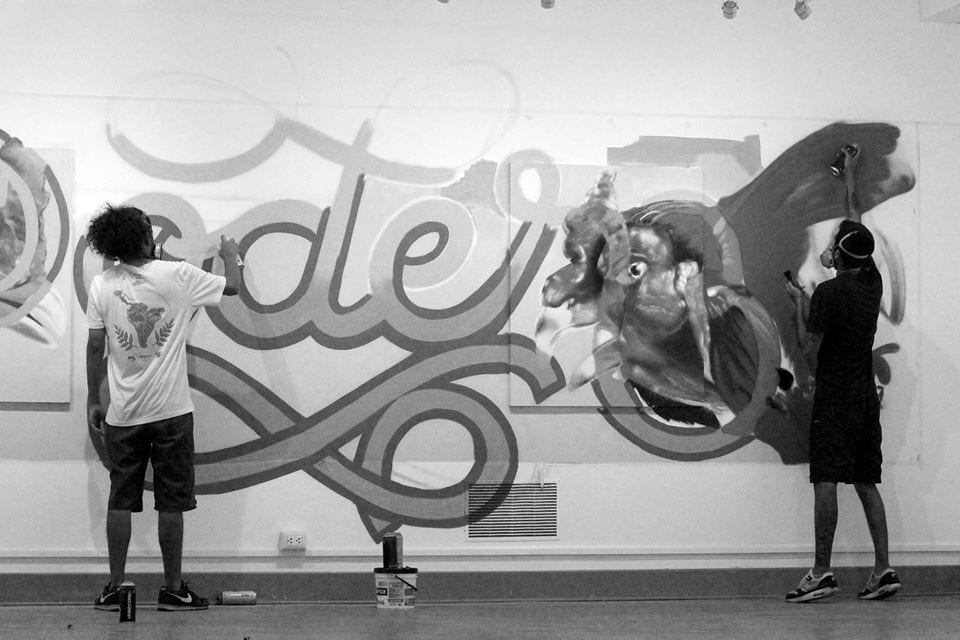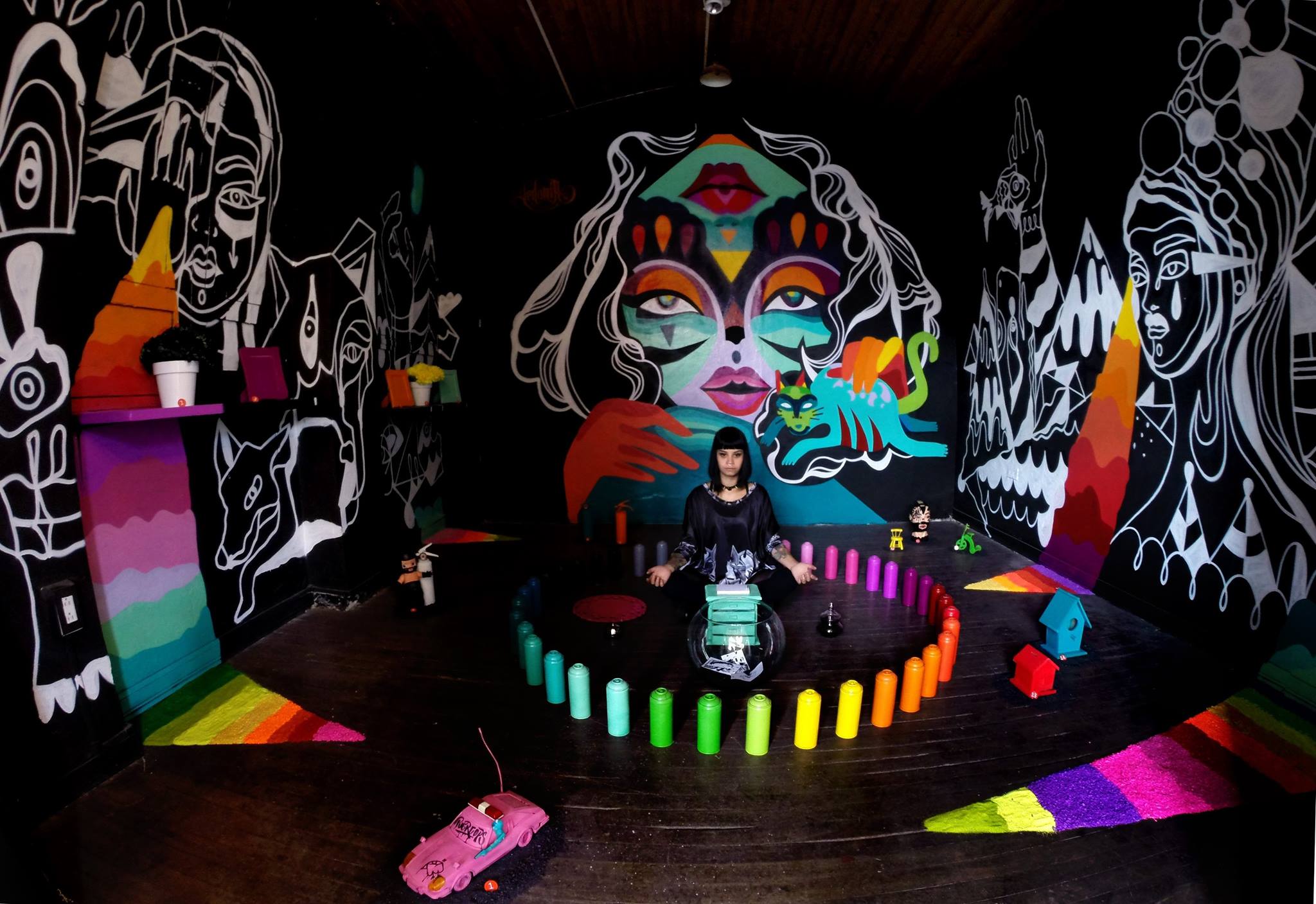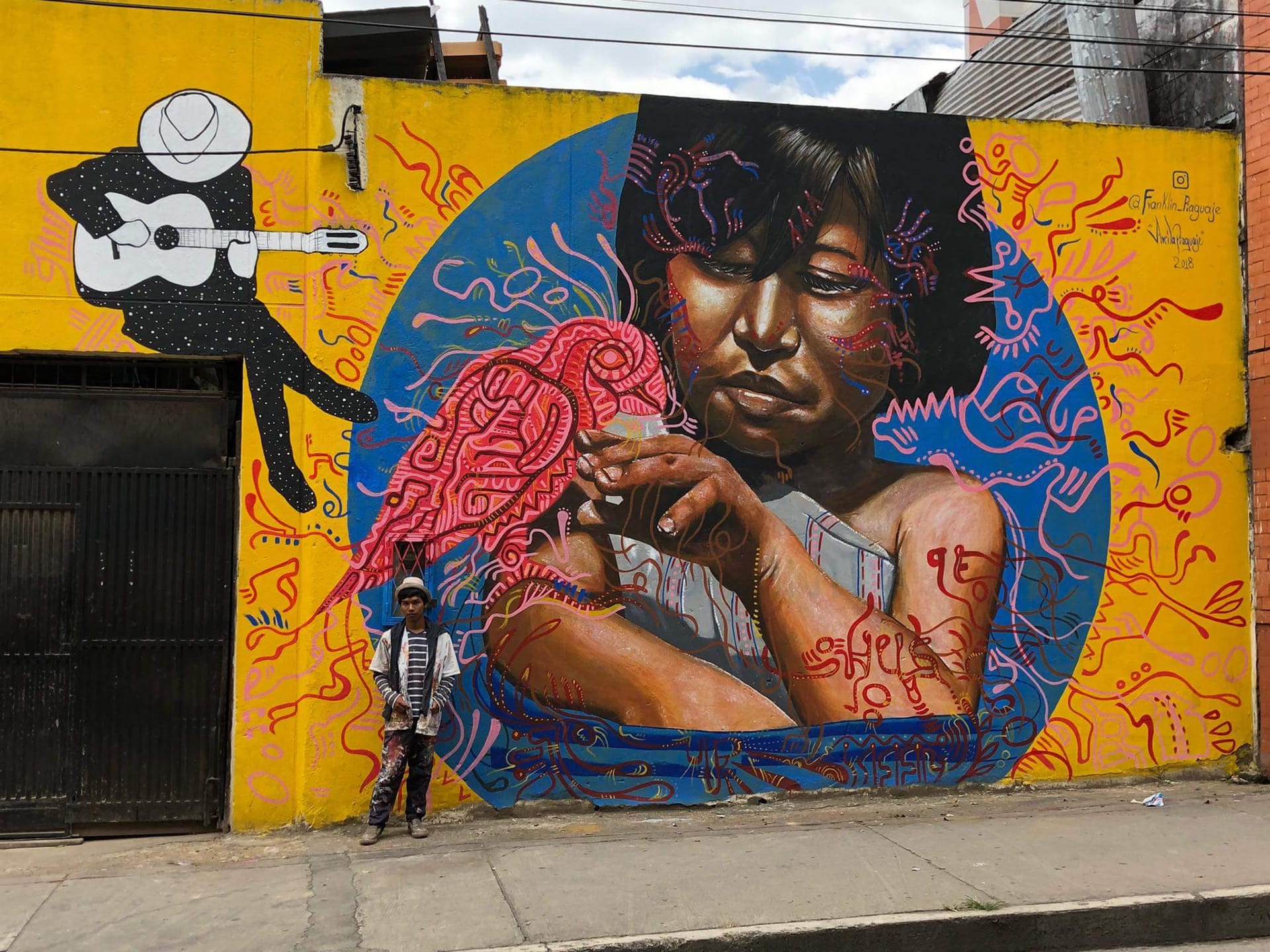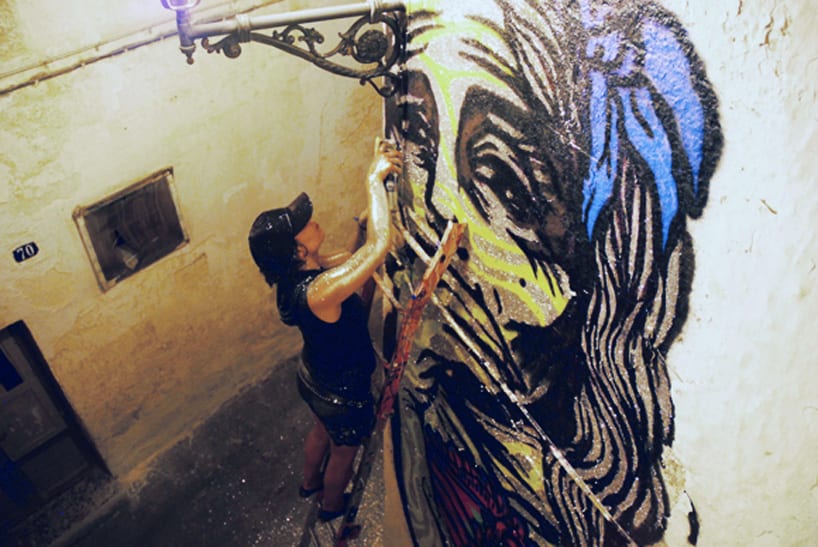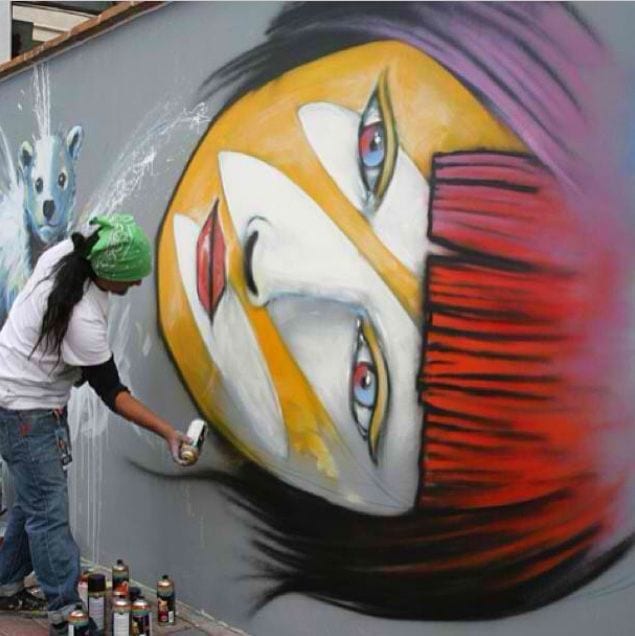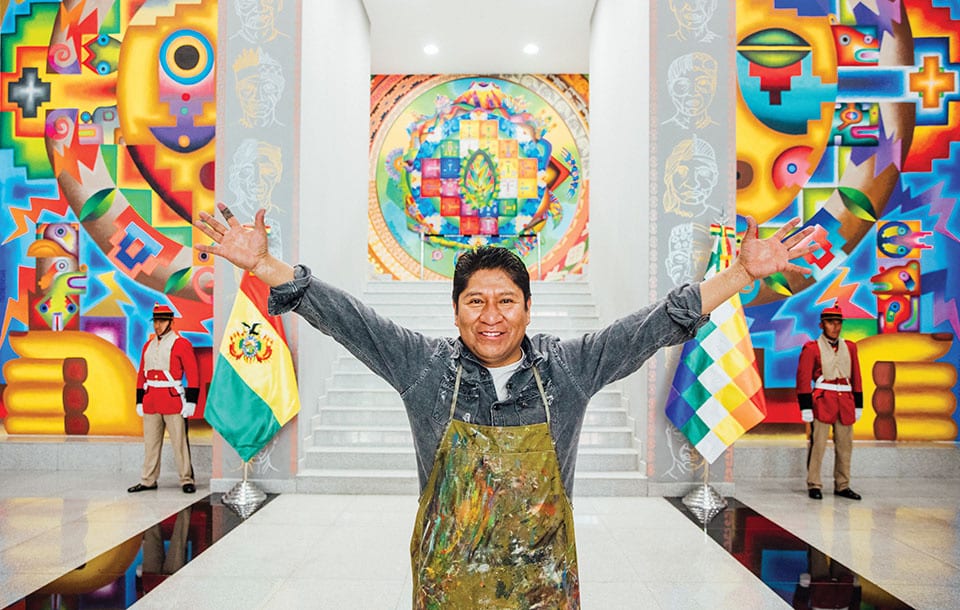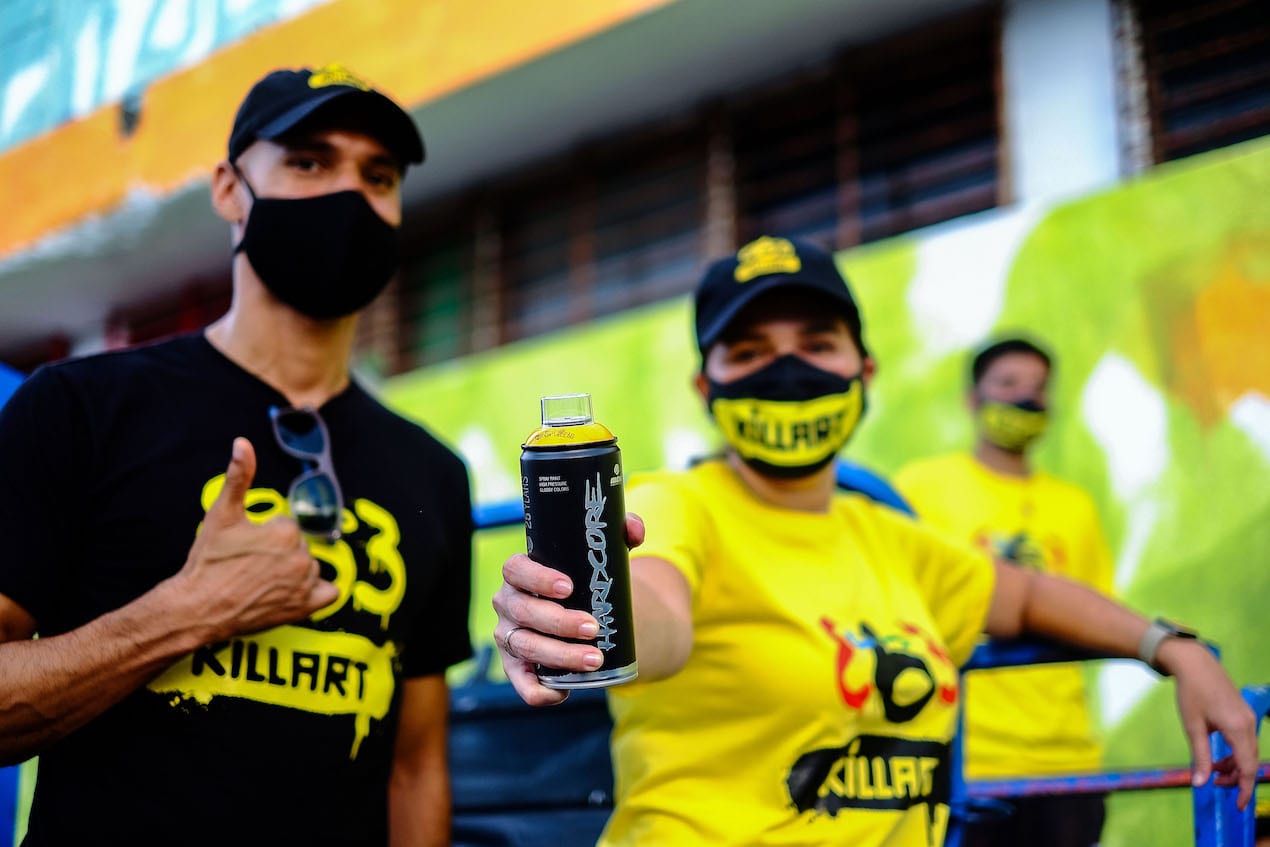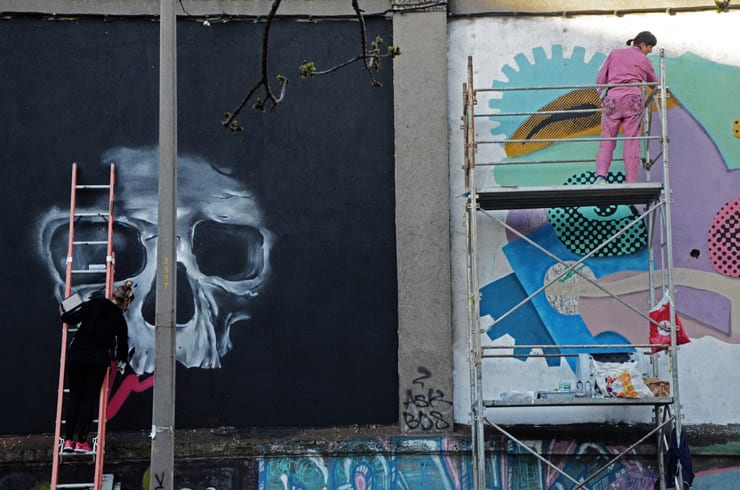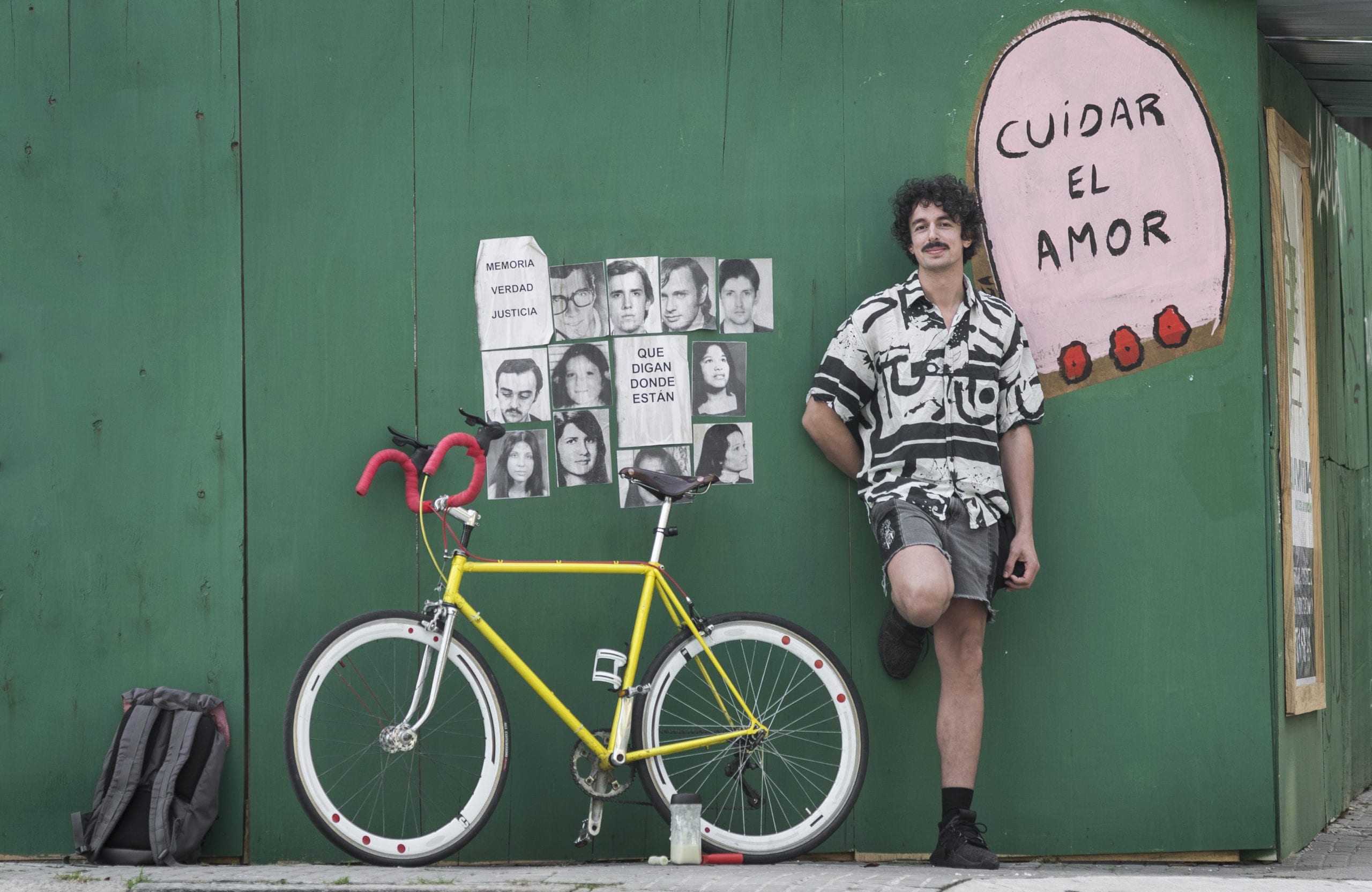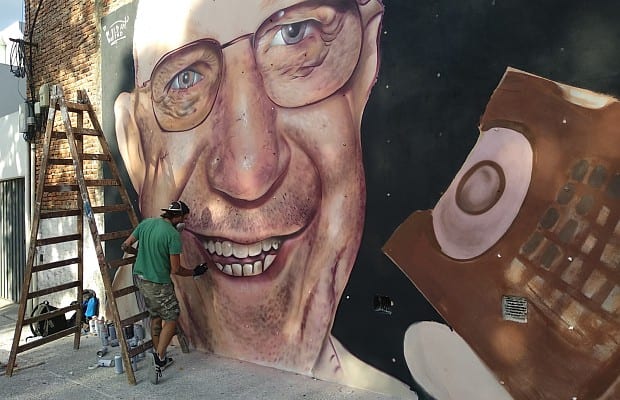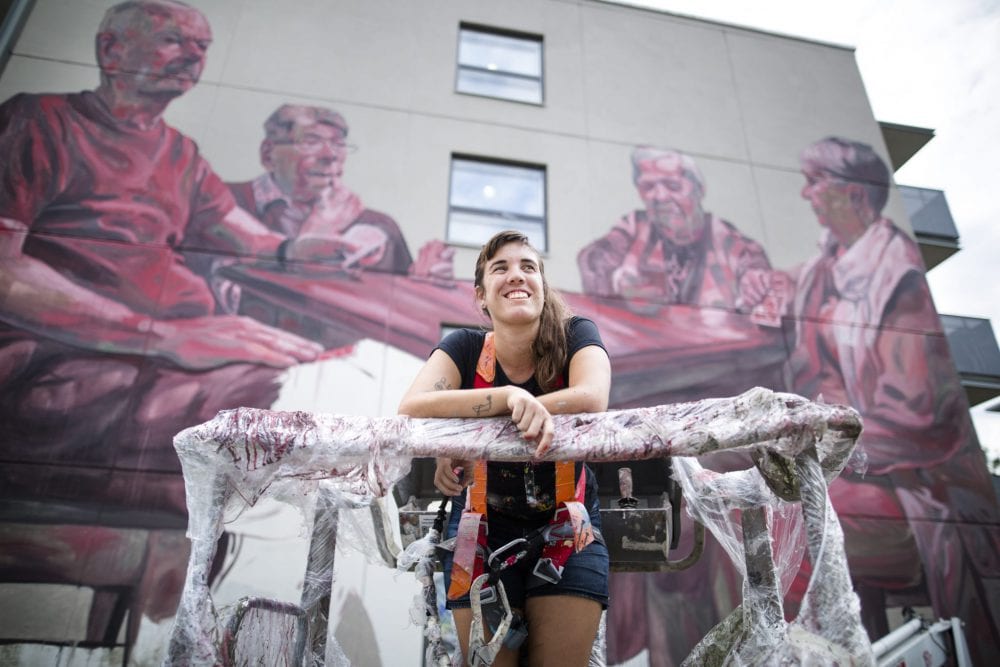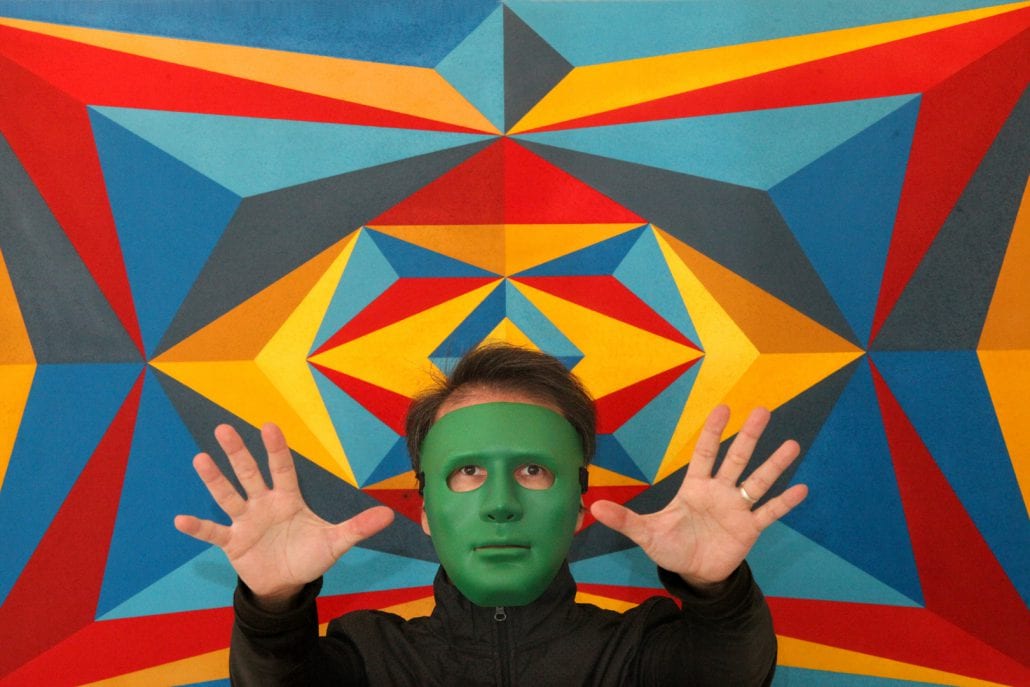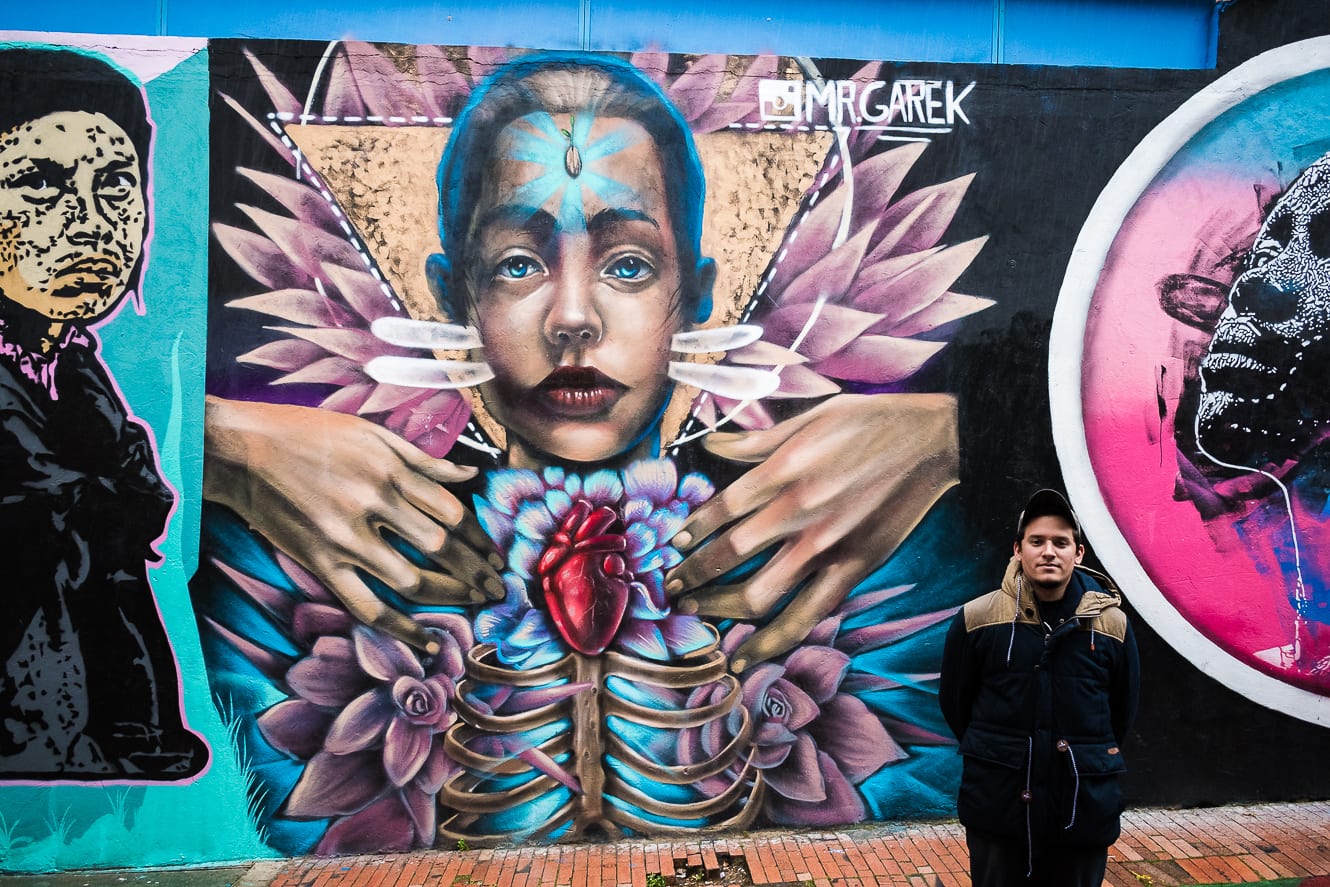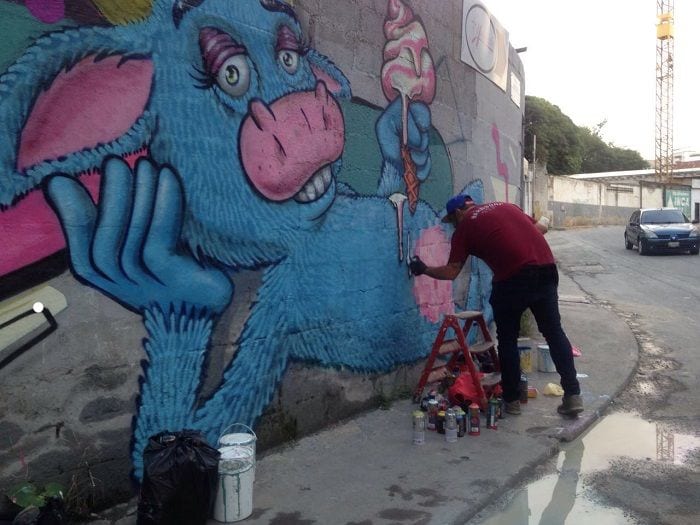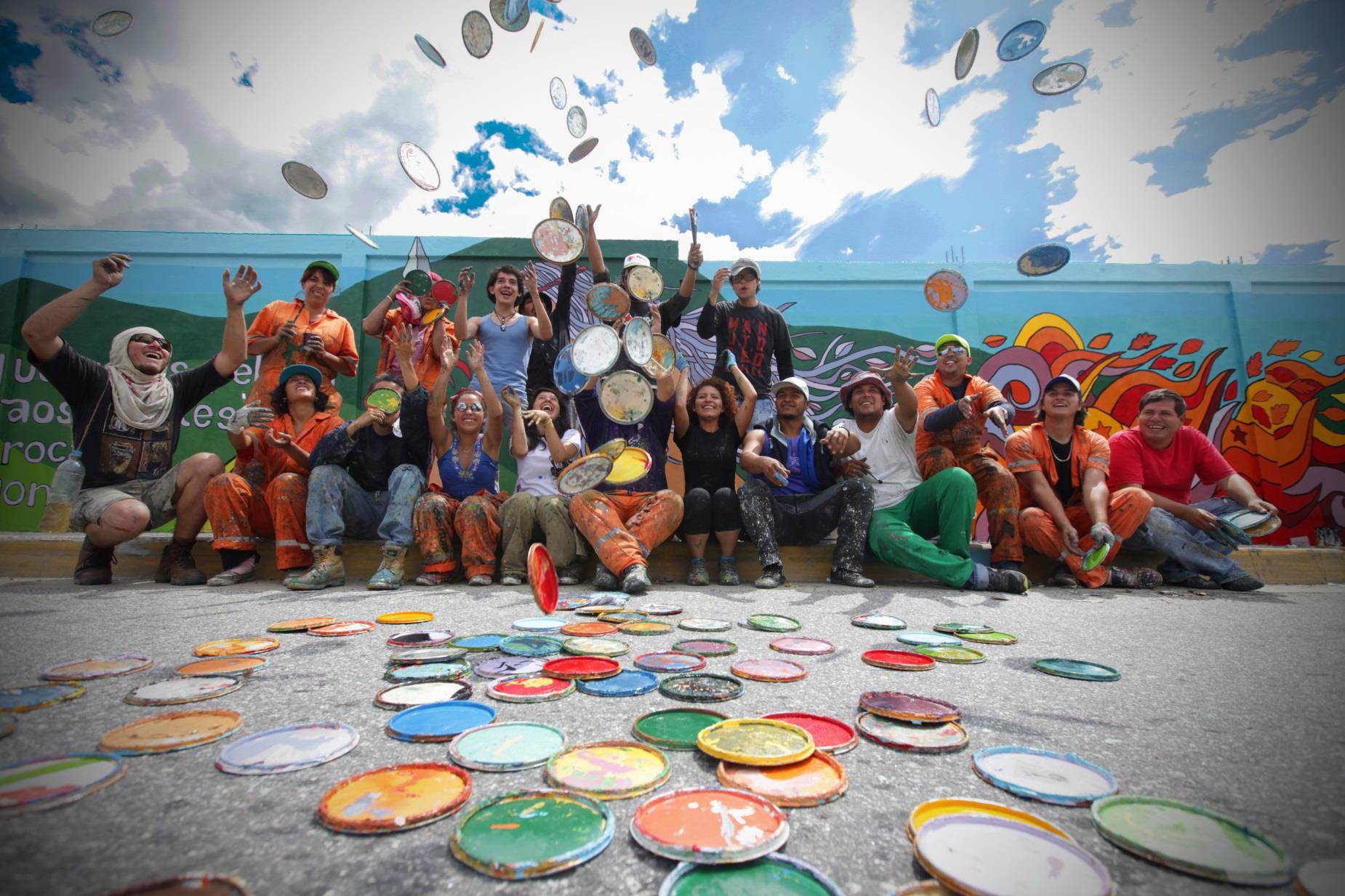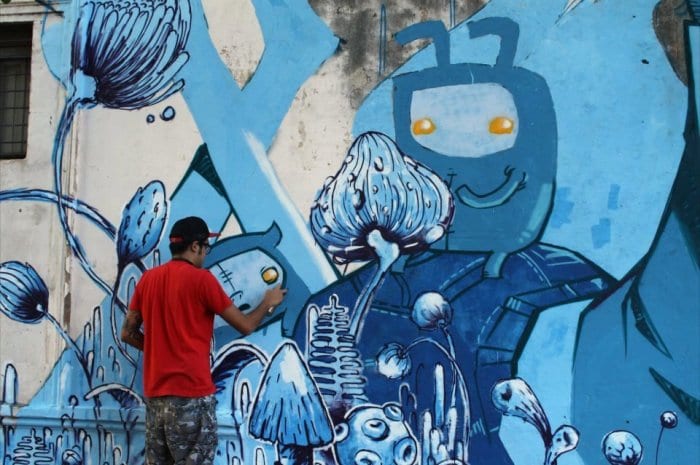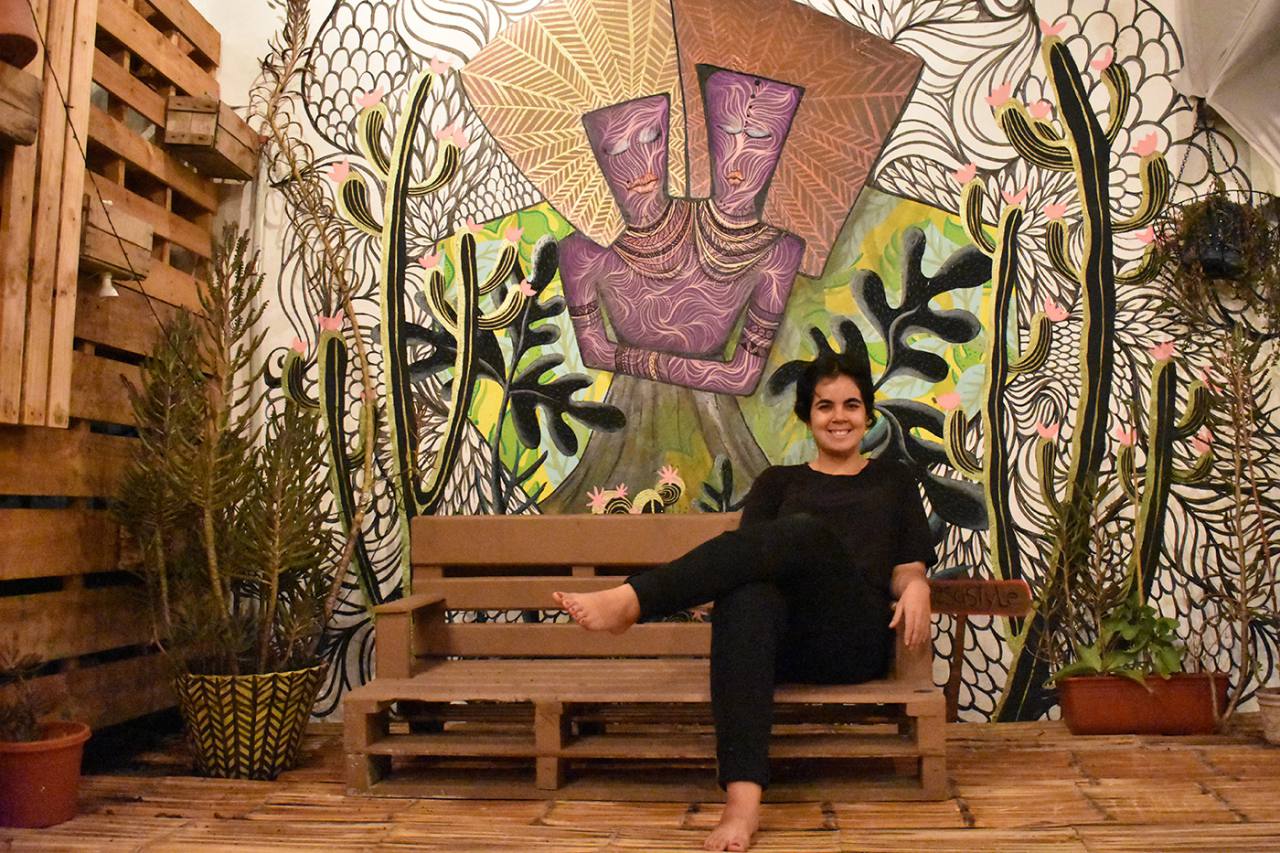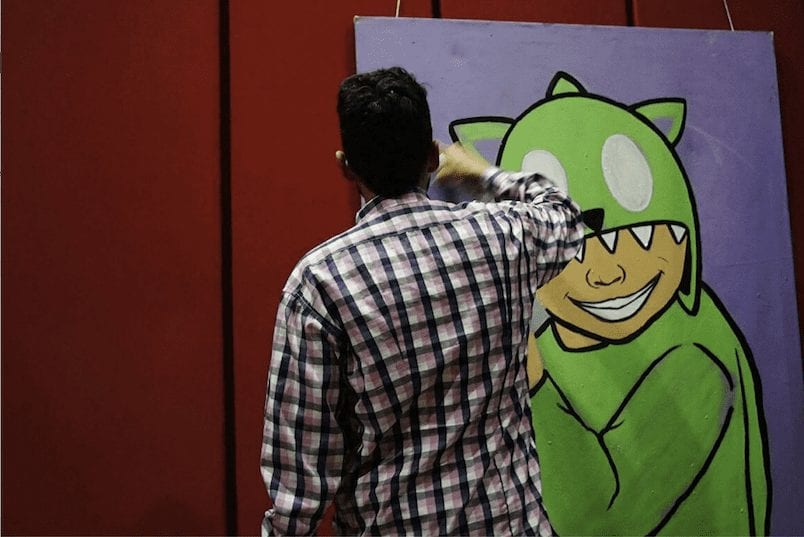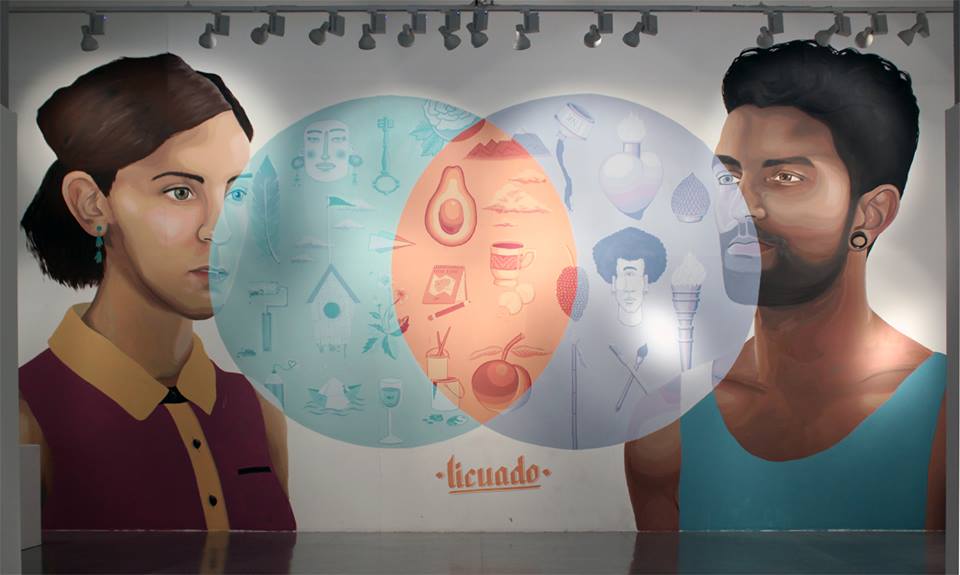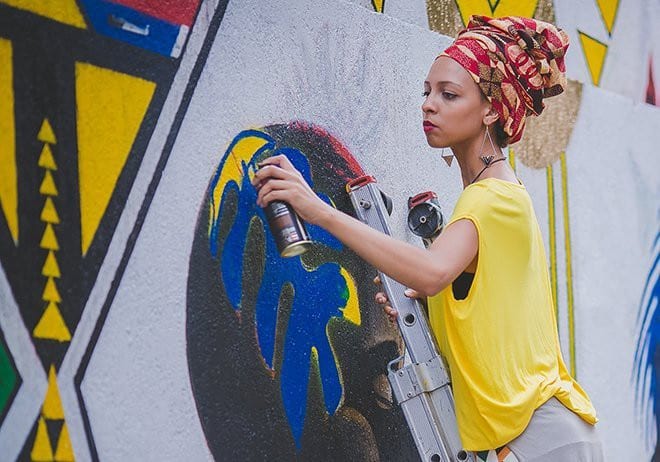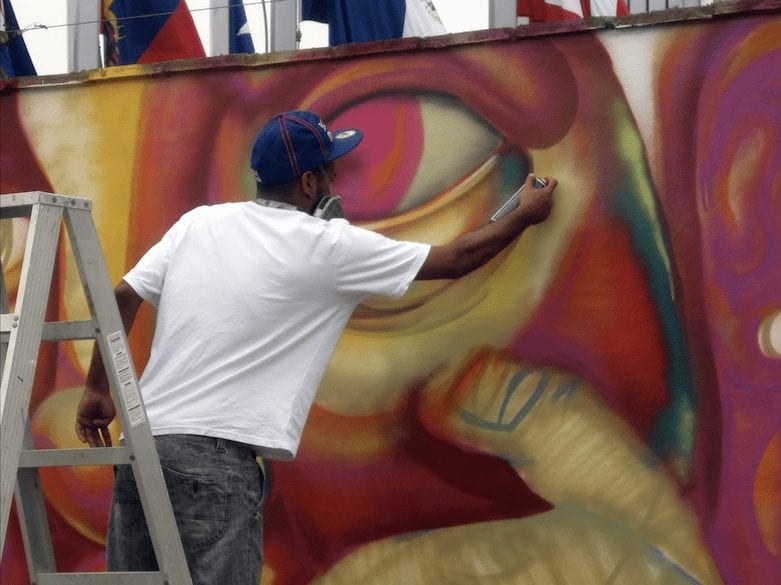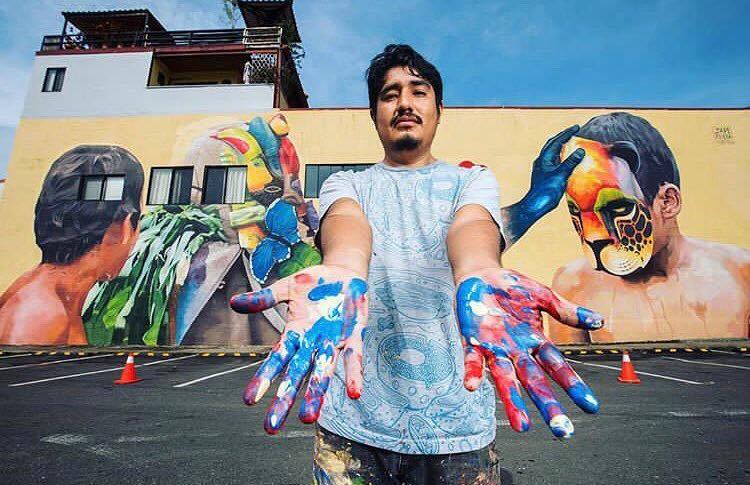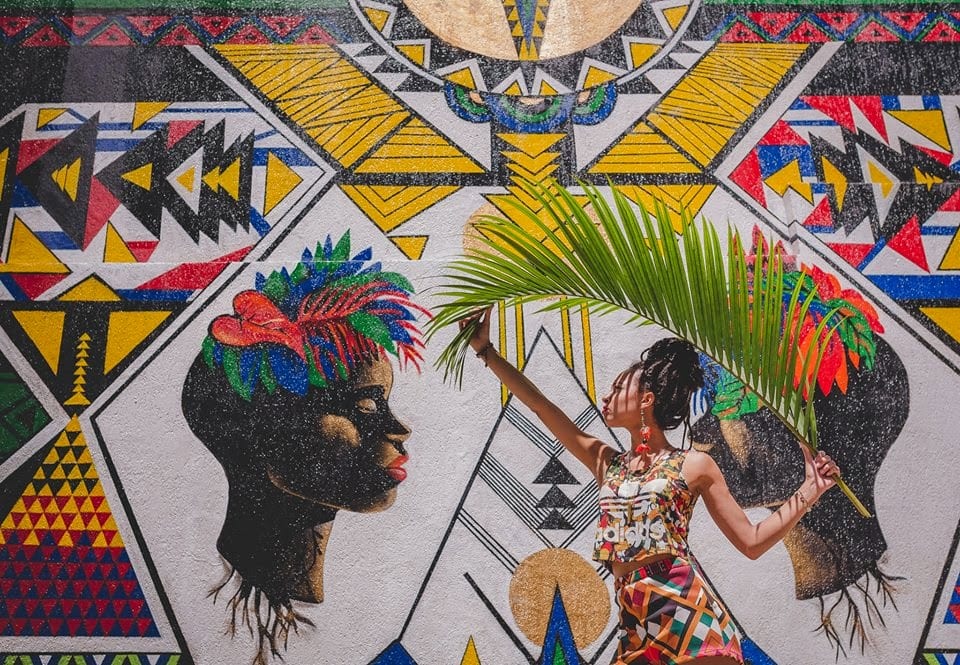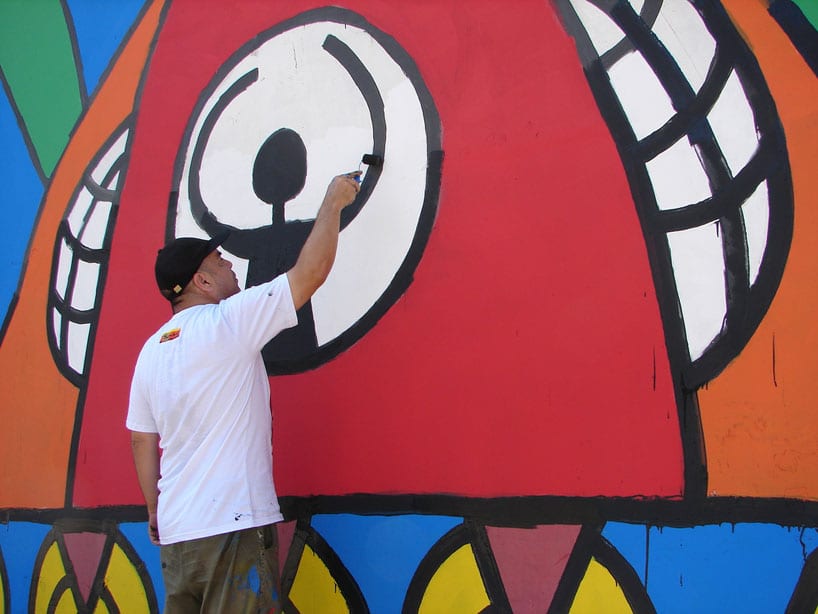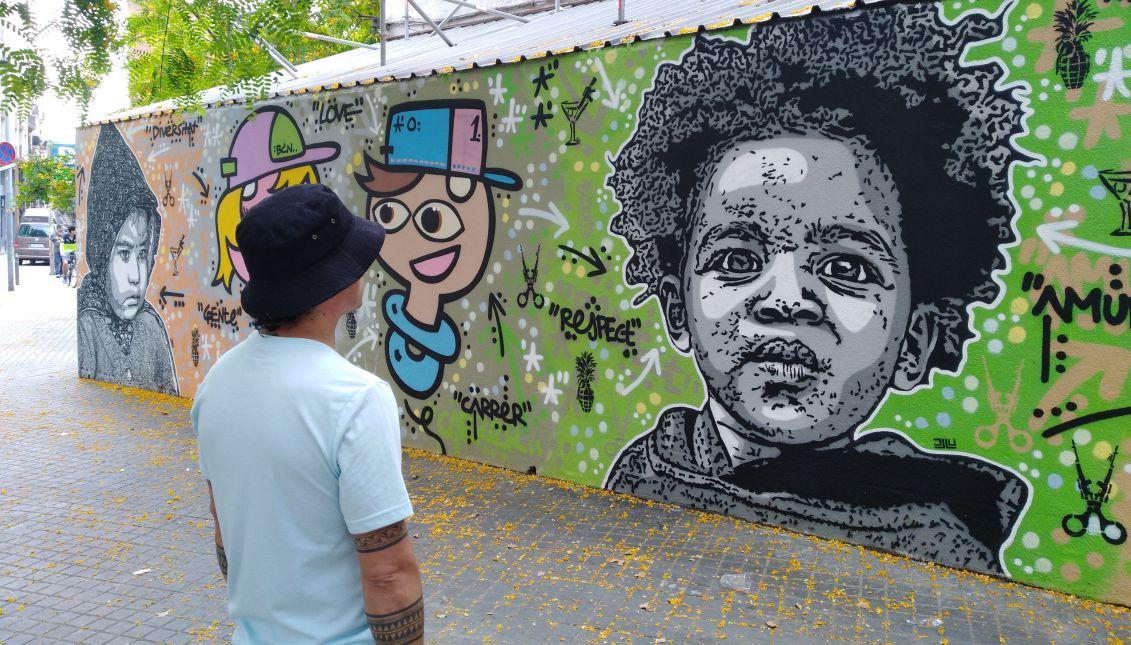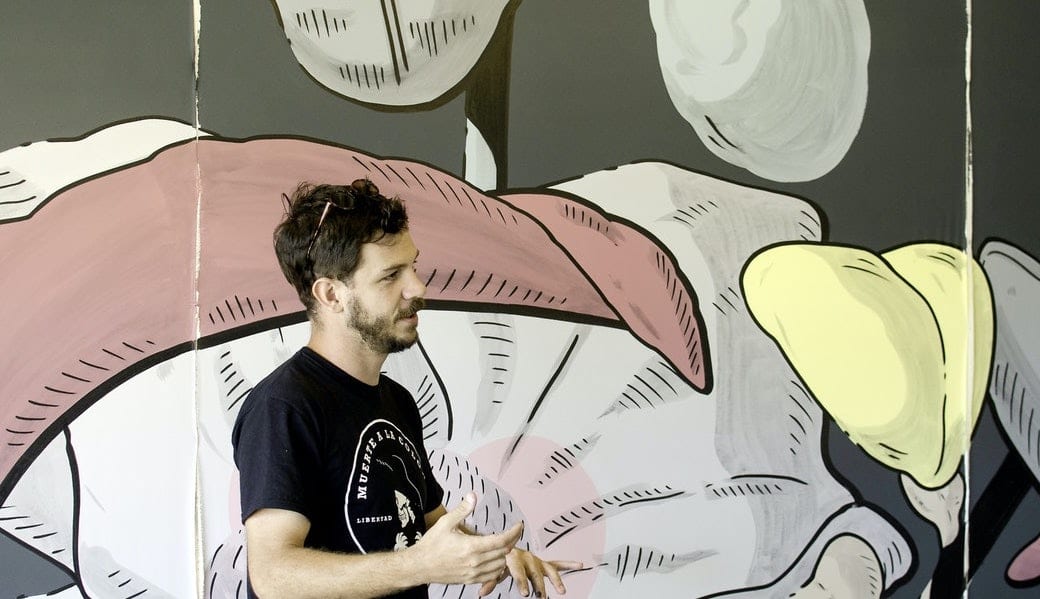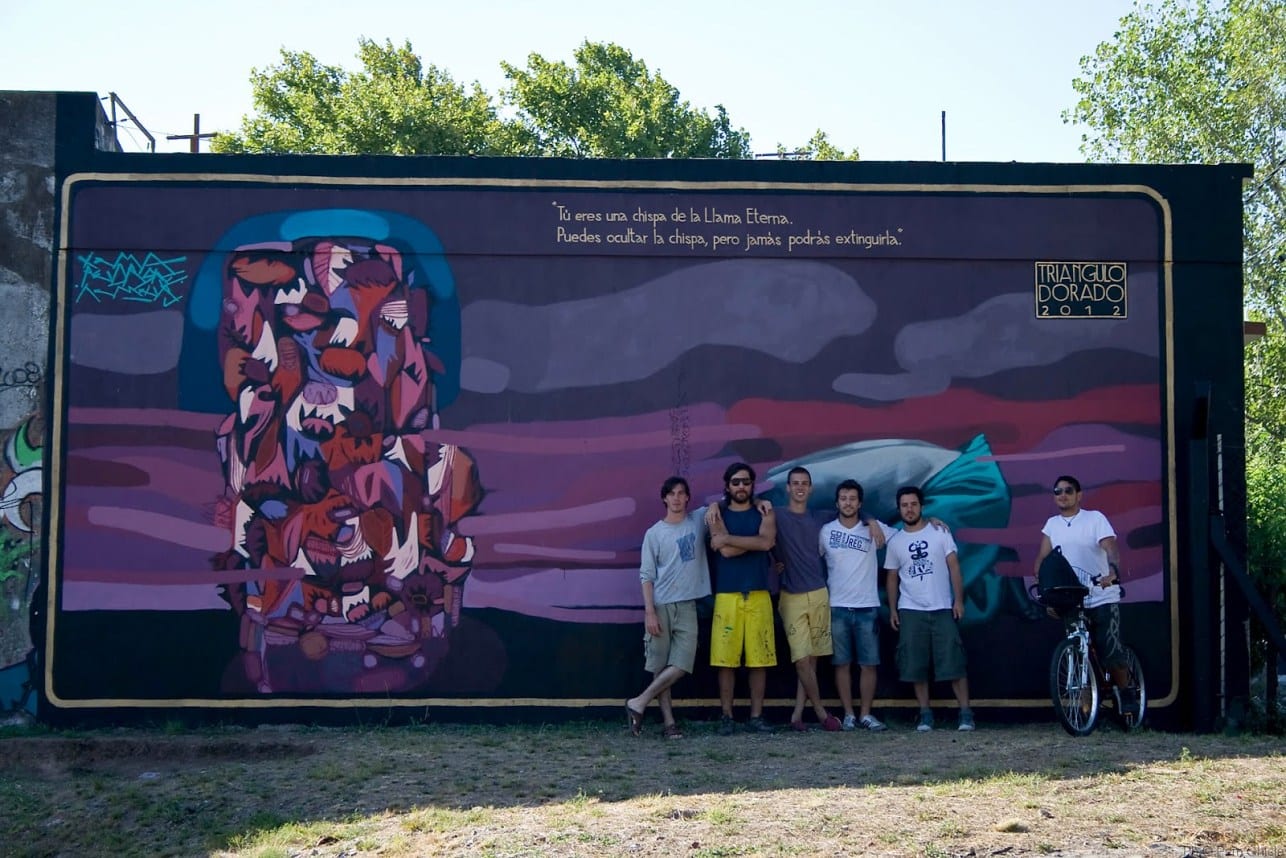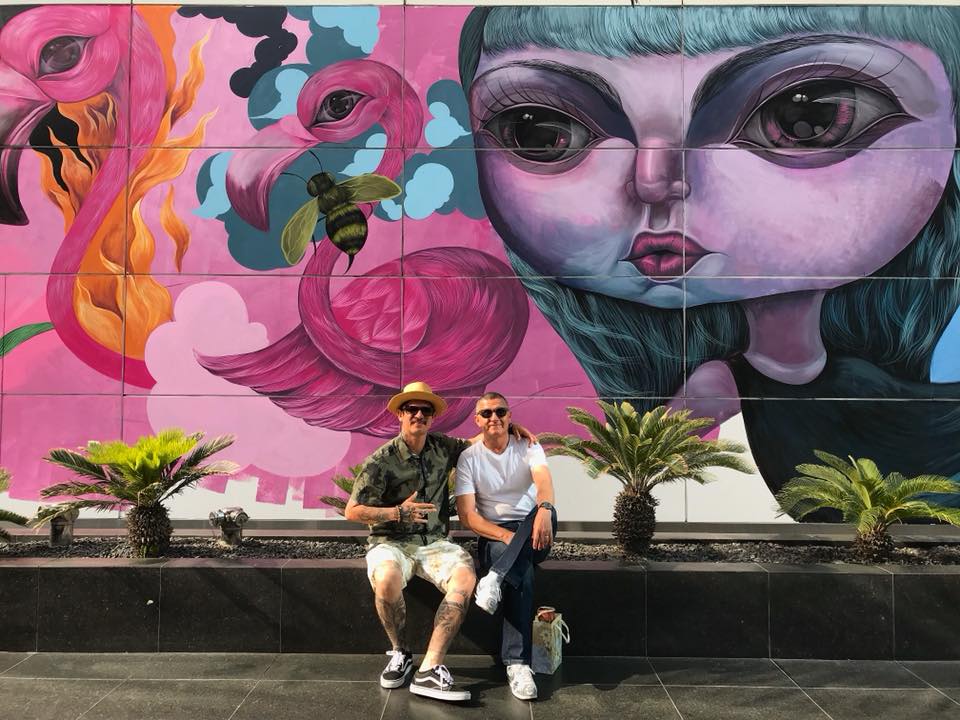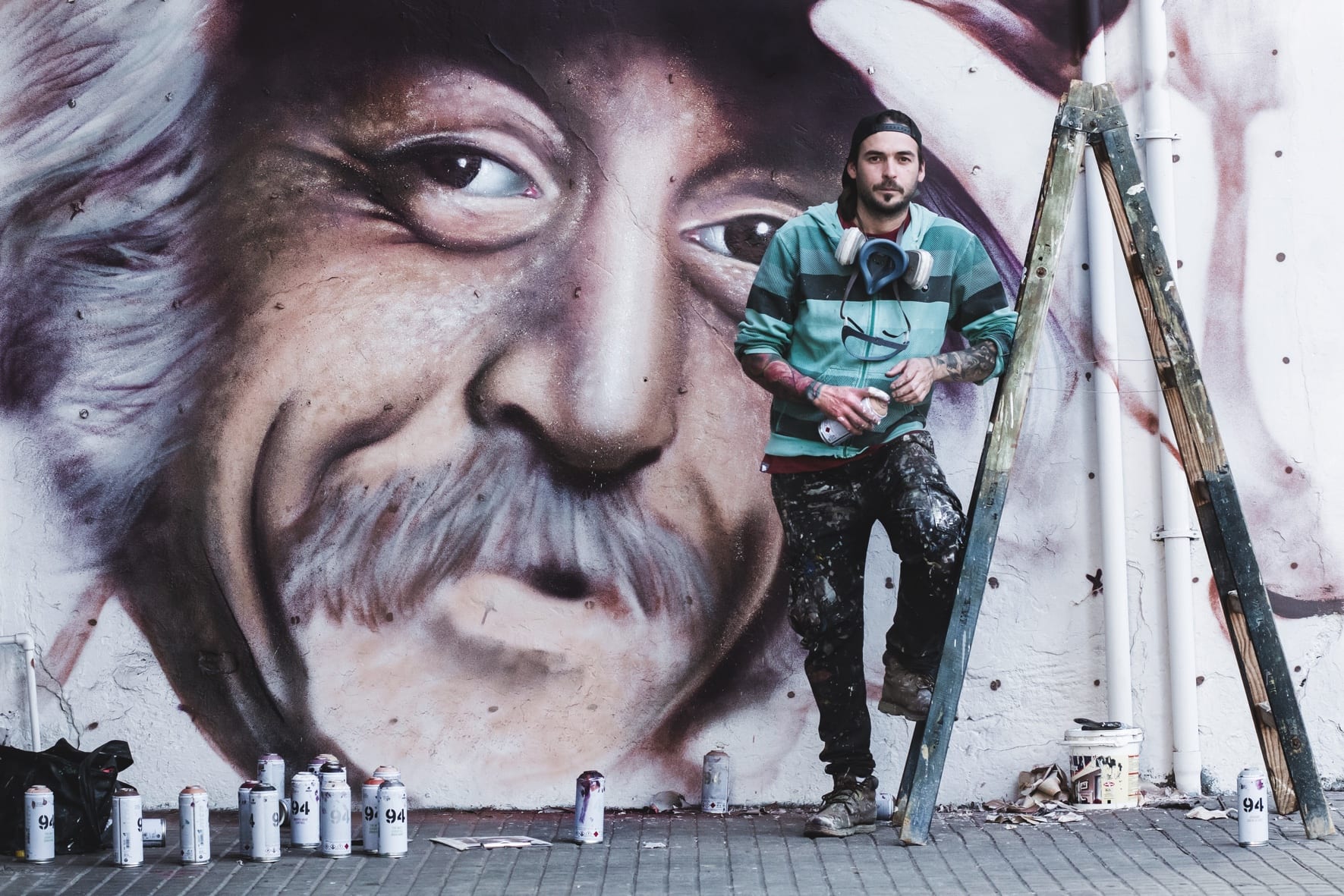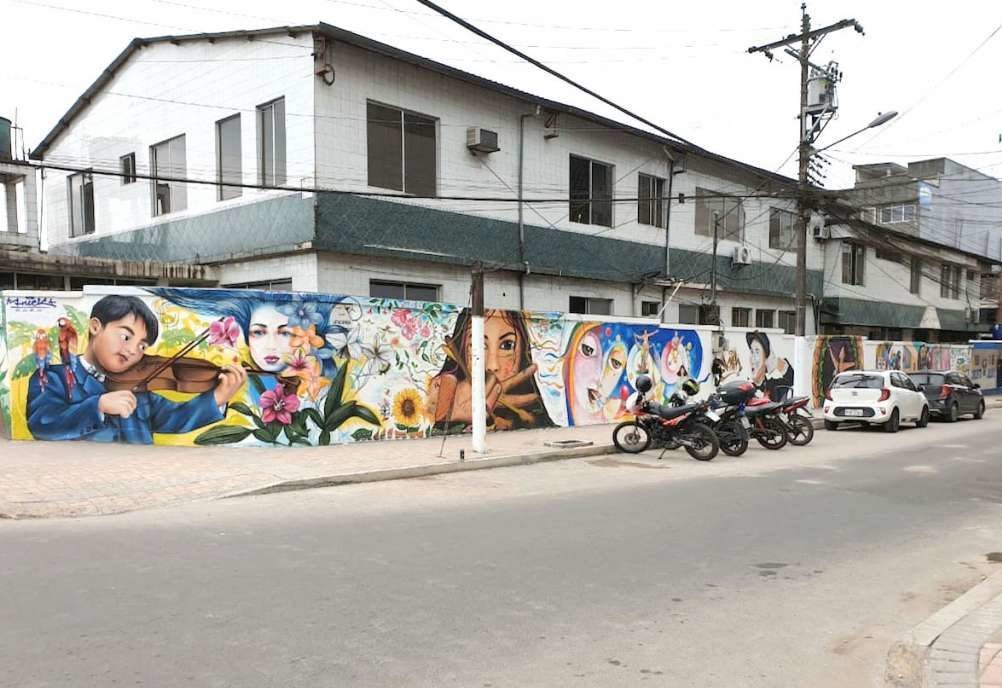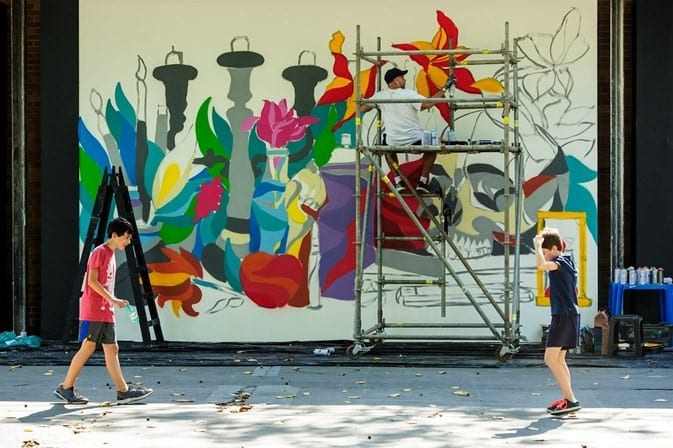Jocelyn Aracena (Anis)
Under the pseudonym “Anis,” the Chilean illustrator and muralist Jocelyn Aracena has earned a prominent place in the urban art scene. Establishing herself as one of the most talented and prolific representatives of the medium, she churns out pieces packed with meaning, symmetry, neon tones, and stylized characters; in which nature and the female form occupy an essential place.
Jocelyn started painting the urban canvas at the age of 12, initially finding it rather difficult since no one in her family was an artist or even had an interested in art. A few years later she took up studying illustration, launching her on a path to eventually produce large and intricate murals.
The biggest challenge she experienced while getting into street art was probably access to materials since they were so difficult and expensive to come by at the time. With her limited resources, she ended up mixing spray paints to get the maximum number of tones of a certain color. She would also collect partially used bottles on paint left on the street that she would be careful to make it last. Painting in this way proved difficult but allowed her to define her own technique with acrylic paints and aerosols.
Anis’ art deals with subjects such as metaphysics, self-knowledge, nature, and the female experience. She says the women she paints could be anyone; an indigenous woman, someone who comes from another continent, a black woman, a white woman, or a Japanese woman. She aims for her characters to be a mixture of all women together, all being one.
To check out Anis’ most recent works, have a look at her Instagram account here: https://www.instagram.com/anis88_cl
Pum Pum
Pum Pum is an urban artist and graphic designer from Argentina, who, although she tries to keep her face and name out of the media, has become one of the most recognized artists in the field of urban art in Buenos Aires. While in the early 2000s many of her contemporaries opted for aerosol as the main material in their works, Pum Pum chose to prioritize latex paint and brushes in figurine-inspired murals.
At some point in her childhood she started drawing and never stopped. A product, perhaps of always being surrounded by art because she had a sculptor as a father and a psychologist for a mother. Eventually, she started making small images by hand and sticking them to city walls and, through this first step, came to fall in with a group of other artists; for next to her simple early works, other artists would add theirs too, collectively adding presence to random spots in the city.
Pum Pum is known for her iconic two-dimensional child-like characters; a result of an eclectic influences that ranges from Hello Kitty to American punk rock bands. She illustrates her characters with strong colors and fine lines, resulting in vibrant compositions.
Pum Pum has an Instagram account where she continues to add her most recent creations. Check it out here: https://www.instagram.com/holapumpum/
Kocha Se Raya
KSR stands for Kocha Se Raya, a group of urban artists from Cochabamba who have been painting the walls of the city for some time now. The crew includes artists Oveja213 and Puriskiri, both of whom have a long history in the Colombian street art scene and who have participated in numerous national and international events and festivals.
The KSR collective fuses elements such as typography, lettering, and realism. In recent years, they have intervened in many spaces in the city in order to, as they put it, “give it a break from political propaganda and advertising that try to tell you what to buy or what to do.”
According to them, graffiti is always going to be about rebellion, because whether it carries a message or not, it appropriates public space, and serves as a counterattack against propaganda, and advertising. For the collective, covering an advertisement with graffiti is reducing the strength of consumerism. Their work also adds elements of flora and fauna native to their country, reminding people of the importance of nature and national heritage.
You can check out KSR’s recent work on their Facebook account here: https://www.facebook.com/ksr.cru/
Diana Ordóñez (Ledania)
Diana Ordóñez, better known as Ledania, is a Colombian artist from the city of Bogotá who offers a fresh and different perspective on art. Apart from creating street art she also works with plastic sculpture and does quite a lot of photography and graphic design. Her best-known creations are found on different walls of the Colombian capitol, in the form of street art and large murals, although she has broadened her approaches through the years and now creates decorative objects and a line of clothing.
Ledania’s style is vibrant and ornate, exploring the genre of expressionism, cubism, and surrealism to capture her artistic vision. Her drawings and graffiti mix elements of these three movements to create something new and fresh. Through the process of relating her own methods to those of artists from different movements, she is able to create pieces containing unique and novel figurative personalities; some closer to realism and others more related to expressionism with exaggeration and distortion of some characteristic features.
She uses geometric shapes for the composition of her subjects and sometimes creates collages of different images to achieve a new and different effect, adding depth to these characters using symbolism and transposing elements to represent what they are meant to feel and convey.
With her large palette of colors and geometric figures, she continuously keeps us looking forward to her newest creations that can be found here: https://www.instagram.com/ledania/
Franklin Piaguaje
Franklin Piaguaje was raised among the Siona, one of the 102 indigenous communities that inhabit the Colombian territory. An indigenous man who from a very young age was instilled with the value of care and conservation of nature. Franklin was educated with a sensitivity to issues that affect the country at large, training that compelled him get involved in protests and mobilizations in defense of different struggles such as education and territorial rights.
In 2012, when he was 14 years old, he began to experiment with sculptures in plaster, clay, and porcelain, materials that he learned to handle thanks to tutorials he found on the internet. Soon after, he also began making drawings with with oil paint, charcoal, and pencils, though it would take several years before he took to the streets with his artwork.
It was in 2016 that Franklin decided to start creating work in a more serious way and with greater social commitment, addressing issues such as childhood, violence, and the reality of the country he lived in. Together with a group of friends he painted murals where there was political advertising, sometimes covering it with artwork related to education, violence against women, rights of ethnic groups, and protection of flora and fauna.
Franklin has stated that the concepts he deals with in his work vary, according to what he is experiencing at certain times. In addition to expressing his indigenous heritage with pride, Franklin paints portraits of artists and fictional characters as superheroes in his spare time, something that serves as an exercise for other projects.
You can follow Franklin Piaguaje’s work on his Instagram account here: https://www.instagram.com/franklin_piaguaje/
Bastardilla
Bastardilla is the name of an urban artist who was originally born in Medellín but grew up in the Colombian capital of Bogotá. Her work aims to create a dialogue with passersby on the street and the thick lines she uses in her creations tell stories she hopes will connect with the locals where her murals are created.
At the age of 13, Bastardilla discovered that walking on the street and wandering was an experience she loved, but for some time she thought that painting without permission was a complicated and dangerous endeavor. The moment came however, when her gaze broadened and she began to see the movement of graffiti and urban art as an opportunity to be in line with her interests so she put aside her prejudices and fears.
Today, her work is scattered around various corners of the globe, painted on walls, doors, and corrugated shutters of shopfronts; her characters exhibiting female faces with Latin features, often semi-hidden by their hair, and almost always accompanied by flowers, hummingbirds, and glitter splashes that attract the attention of people passing by on the street. Often, her works speak to the violent circumstances that women in Latin America sometimes experience. Bastardilla paints characters that originating from intimate, ancestral, personal, and public stories and her work becomes a social example, learning from other people, and from herself.
You can follow Bastardilla on her Instagram account here: https://www.instagram.com/imagenbastarda/.
Steep
Steep is an academic artist born in Ecuador who feels the need to look for alternative spaces where his creations can be realized. That’s how he found, in the walls of various cities, spaces where he could express his unique vision he calls “Explosive Realism” thus creating environments full of mythical beings and fantastic characters.
The presence of planetary flora and fauna is essential in his compositions, as well as ancestral magic, a lot of realism in contrast with explosions of color, elements that work in conjunction to establish a connection with the passerby.
For 10 years now he has managed to create fantastical characters and portray them in natural settings drawing on his Latin American heritage. Not only do his paintings enhance the urban landscape, thanks to his “explosions of creativity” concept, he manages to capture the vitality and serenity he sees around him.
Using a unique technique of blasting or dripping paint that he has been perfecting since the beginning of his work, he strengthens lines in his creations, imprinting his personal touch onto the figurative representations of animals, indigenous people, water, jungles, myths, and ancestral knowledge. Likewise, he integrates materials such as acrylic, spray paint, rollers, brushes, and stencils to achieve his characteristic style.
You can see more work by Steep’s on his Instagram account here: https://www.instagram.com/steep_aeon/
Knorke Leaf (Norka Paz Rodo)
Knorke Leaf, a.k.a Norka Paz Rodo is a very talented muralist, illustrator, and engraver born in La Paz, Bolivia. With many works scattered around the capitol, she has also painted internationally, with works exhibited in Argentina, Brazil, Spain, and the United States, as well as several other cities in Bolivia. This has allowed her to become one of the most influential figures in the street art scene of her country.
For more than three decades now, Knorke has been hard at work creating, stating that her mother got her painting from the age of two years old. So, between precociousness and practice, Knorke’s career has had a steady trajectory towards becoming an artist. As soon as she graduated high school she enrolled in a course to study plastic arts at the Universidad Mayor de San Andrés, specializing in engraving. At the same time, she took courses in Biology because she had an interest in nature conservation. Eventually, she realized she was more of an environmental activist than an academic, so she continued on her path to becoming an artist.
Knorke Leaf’s art attempts to break boundaries and her intention is to touch the extraordinary, the joy in life, and to experience the profound through the infinite possibilities that art offers. She possesses strong environmentalist convictions that she expresses through her art. Environmental degradation, threats to indigenous and peasant territories, the destruction of biodiversity, all of these are issues that society should be concerned about and that the media does not always reflect properly, so Norka has taken up the task of expressing it through her murals. The artist also advocates for women’s struggles and is committed to culture and the preservation of ancestral values.
You can follow Knorke Leaf’s work on her Instagram page here: https://www.instagram.com/knorke_leaf/
Roberto Mamani Mamani
Roberto Mamani Mamani, of Quechua birth and Aymara blood, was born on December 6, 1962. From a very early age, his need for creative expression led him on a path to becoming an artist. Since 1983 Mamani Mamani has held over 52 exhibitions, including 44 solo events that have garnered him numerous awards and distinctions through the years. The inspiration for his art is tied to his culture: the rituals, dances, food, spiritual visions, and the feelings of his community, always respecting mother earth Pachamama.
His first paintings arose from childhood games with stones and clay, painting with the ashes from the fireplace; subjects drawn from daily life and the agricultural tasks of his parents.
Without formal training, he managed to depict his world with originality and authentically. His artwork is an introspective and scrutinizing vision of the vast and rich Andean world. Color and shape are the nexus between the artist and his world, between his origin and his authentically Aymara worldview. He has dedicated his life to expressing through painting the Aymara vision of the Andean Universe. Roberto has developed his art based on the culture and spirit of his people; a vibrant and vital land, full of colors, character, textures, and emotions, like the Bolivian land he inhabits.
You can follow Roberto’s recent work on his Facebook account here: https://www.facebook.com/Mamani-Mamani-el-Artista-100530878283003/
New Killart Wall Paintings Arrive in Barranquilla for its Latest Edition
On September 23rd, 2020, artists entered in the 2020 Barranquilla (Colombia) Graffiti and Urban Art Festival popularly known as "Killart," and began painting their murals in spaces designated for this year's edition of the event.
Participating artists include: Ceam Ceas, Law Carvajal, Luis Amaris, Keko Angulo and Brik One, Norella Magdaniells, Omar Alonso, and Yuyo del Valle. These eight artists will begin to leave their creative mark on the sites chosen by the French Alliance, organizer of the event, hand-in-hand with the Secretariat of Culture, Heritage and Tourism. The works are scheduled to be completed on Wednesday, September 30th, when the official unveiling will be held and the fences that restrict the area to avoid the spread of Covid will be removed.
This event is partially made possible through the support of the Lienzo Urbano Foundation, the Ministry of Culture, the National Program for Cultural Concertation, the Chamber of Commerce of Barranquilla, and Coverfil Pinturas.
The festival has three main categories:
– Killart Street: A total of 5 artists will paint murals on 5 walls in the public space with an open theme, where the artistic style of the participants can be appreciated.
– Heroes of the pandemic: An artist will design and paint a public mural to pay tribute to healthcare workers for their remarkable performance in response to the pandemic.
– Killart at the Cortissoz: Several artists will paint murals that pay tribute to the evolution of the city. Winning murals in this category will depict its migratory history which affected culture, gastronomy, and the overall development of Barranquilla. An area of the Ernesto Cortissoz International Airport has been assigned for these new artworks.
Killart is one of the most beloved events for Barranquilla residents because it puts art at the service of all. It makes Barranquilla an open-air gallery where everyone can walk and enjoy. The event promotes the appropriation of spaces by the creations of local artists as essential for the city, its inhabitants, and visitors.
Along with artistic interventions on the walls of the city, Killart has arranged an academic agenda that includes workshops and talks, among other activities.
Verónica (MIN8)
Born in 1982, MIN8 is a self-taught pioneer of graffiti art in Uruguay and in recent years has become well known across Latin America. She began in graffiti at the age of 15 and, without having formal studies in art, acquired her technique through many years of practice and dedication. Alongside her work as a street artist, she currently serves as a teacher of Fine Arts, for the Universidad del Trabajo de Uruguay, and at Fundación Iturria teaching Graffiti workshops.
Influenced by hip hop and rap culture, Verónica (her real name), started producing graffiti in 1998 which led her to start experimenting with tags and lettering. After five or six years she was already painting as an established street artist and since 2007 she has represented her country in a number of national and international events. Reoccurring themes in her work are the role of women in society and the importance of nature. She has a dynamic style that combines realistic figures with color and the geometric universe.
MIN8 has recently become involved in a project named “Luces,” a social artistic conglomerate that performs various urban interventions in order to support inclusion processes for people in the most vulnerable places such as prisons, disadvantaged neighborhoods, psychiatric hospitals, drug rehabilitation centers among other places excluded by society.
MIN8 is very active as a painter and continues to adorn the streets of the world with her art pieces. You can see what she’s up to on her Instagram account heret: https://www.instagram.com/min_ocho
“Haciendo Calle” Moves From the Web to Guayaquil Communities
With artists such as Andrea Moreira, Ivan Casanova, Chester King Lucky, Made, NeoSudacas, Carla Bresciani and La Señora de los Graffs, the biennial “Haciendo Calle” moves out of its digital stage and goes to the walls of Nuevo Ceibos in the Ecuadorian city of Guayaquil.
The festival started in June 2020 through social media due to the current pandemic, with a series of urban interventions by both national and international artists that went through August and were being updated through the festival’s Instagram account. However, the inhabitants of the Nuevo Ceibos locality reached out to the representatives of the festival with the intention of painting several murals, turning the so-far digital-only festival into a face-to-face event.
The project is led by researcher teacher María Fernanda López, in conjunction with muralist Carla Bresciani, and it’s centered on exposition, developing critical appreciations, and promoting a pedagogy between the artists and the community.
This face-to-face part marks the end of the first stage of the biennial festival that will have an additional stage in October. This next part of the event is already being developed and focuses on generating a platform and critical reflection to analyze the whole process on multiple levels. With the participation of communal representatives who will bring their opinion to the discussion, this year plans to have spectacular results.
Gastón Rosa (Untonga)
Untonga, whose real name is Gastón Rosa, lives in Montevideo, Uruguay, where he “wallpapers” the city with his epitaphs and phrases written in public spaces. His compositions tend to be simple words framed in a particular way: a pink semicircle, three flowers, and a message, a combination resulting in his characteristic “pink gravestones.” This motif has been ever-present in his career, and using this visual style, he attempts to convey the values of diversity, respect for others, and inclusion.
The gravestone shapes seem almost infantile with their hastily rendered simplicity, however, behind this style of drawing, some deep truths are revealed. Untonga’s use of satire allows us to contemplate a “pink” death, which, according to the artist, does not contradict our typical notions of death, but helps us understand life and death in a different way.
However, in this case, to the artist death is not just a physical unraveling, death occurs with any crisis. His pieces tend to speak of broken relationships, job losses, or life projects that are truncated and for which we must mourn and turn the page. Through these thoughtful reminders on city walls, his goal is to help us put things into perspective and move ahead with optimism.
He usually paints the gravestones on kraft paper and sticks them up at night, all of them are unique and all are made by hand. There are also variations with graffiti and various phrases written with marker on shop’s windows.
Untonga draws up different phrases that can brush the poetic, like: “when you were gone I ate what you left, I lay down on your bed, I thought about opening a drawer, I listened to your music, I missed you, I wrote you this”; or depicting day to day activities with apparent simplicity with: “what happens to the neighbor, happens to you” and “if you feel like dancing, then you’re home.” His phrases generate hope and although we know that not everything is always positive, we can embrace the idea that in hard moments empathy can save us.
Untonga’s artistic possibilities are limitless and he continuously shares more of his pink gravestones on his Instagram account: https://www.instagram.com/untonga___/
José Gallino
José Gallino has become one of the most talked-about names in the Uruguayan street art scene. This 33-year-old has produced an enormous number of murals, so many that he has lost count of them. He was born in the city of Salto and managed to make a name for himself by portraying the most prominent figures he could come up with, and doing it nonstop for years.
Since 2016, Jose Gallino has been developing into a project he calls “Tribute to Uruguayans,” a compilation of realistic murals adorning city street walls the width and length of Uruguay. Jose felt it was important to portray the faces of prominent people in various localities around his country, both easily recognizable people and the “invisible” people who still do a lot for their communities.
His works focus on enhancing the legacy of national figures, such as “China” Zorrilla, Alfredo Zitarrosa, Carlos Páez Vilaró, and Eduardo Galeano, to name just a few examples of portraits scattered around Montevideo that bear Gallino’s signature.
Even though these photorealistic portrait murals are a big part of Gallino’s work, he has also dabbled with different characters designs, his first mural in 2013 was a bug with reptile eyes and shark teeth. Raised in the countryside, Gallino says that animals fascinate him and that he got a number of tattoos inspired by animals that he feels some connection to.
You can follow José Gallino’s work on his Instagram account here: https://www.instagram.com/gallinoart/
Milu Correch
The Argentinian Milu Correch is a specialist in large-scale murals, charged with nostalgia and within a very emotionally intimate atmosphere, creating pieces that evoke the feeling you get from looking at old family photographic portraits. Being the daughter of an amateur painter and a literature teacher, she has traveled Europe performing urban interventions in different cities and different spaces, but she also continues to create murals in her native city of Buenos Aires.
Although Milu is a staunch advocate for urban art in Buenos Aires, she tries to downplay the commercialism and sensationalism that street art and muralism has been generating lately. She says that the way people encounter murals has changed, consumption through social networks has takes away some of the intimacy of seeing pieces in their environment.
When asked what her works are about, she replies that it’s “ambiguous” or “whatever you want,” leaving the viewer free to interpret. Despite this, its undeniable that the role of women in society plays a very important factor in Milu’s work. Women are the protagonist in most of her creations, however, her pieces constantly pay tribute to the human figure in general. Her pieces tend to feature different shapes of masks, locations that remind us of places we visit daily, and, in a lot of cases, are accompanied by elements from nature including animals and sometimes plants.
You can follow Milu Correch via her Instagram account here: https://www.instagram.com/milucorrech/
FLIX
Despite multiple exhibitions of his work in galleries around the world, it seems this artist prefers to keep his name private and exhibits and paints murals under the pseudonym FLIX. A Venezuelan architect who graduated from the Central University of Venezuela in 2002, FLIX wants his pieces to not only captivate and grab the attention of the viewer, but also to break paradigms and wake people up in order to dissolve day-to-day monotony.
His aesthetic employs elements such as chromatic labyrinths, robots, stencils, and various creative scenarios. In this sense, he appropriates public spaces and uses them as a canvas for the activation of urban aesthetics. His pieces he says are all woven into a strategy for constructing new understandings of the urban setting.
While he considers himself an artist who seeks to generate a reaction from the public and who has inserted political commentary into some works, this is not necessarily the intention of his artistic discourse. He always makes sure that these features do not end up defining his overall style.
Urban interventions by FLIX tend to use of subtle strategies and his pieces aim at manifesting desires of the local population through renegotiating meaning and relationship. For example, a piece that reflect the desire for a park in a certain neighborhood, a hopscotch drawing that rises to the sky, or a bus stop full of color that makes it more enjoyable and playful.
FLIX’s work has taken him on a trip around the world and he continuously provides updates on his most recent creations. Feel free to have a look on his Instagram account: https://www.instagram.com/flixrobotico/
Jean Betancourt (Mr. Garek)
Jean Betancourt, better known as Mr. Garek is a Venezuelan animation specialist and muralist living in Bogotá, Colombia since 2018. Mr. Garek’s work has been mutating over the years, started with pure graffiti, he started moving towards a more figurative style and now his work is characterized by a the use of a high degree of symbolic elements. Some of the most common themes this highly talented Venezuelan artist addresses are identity, migration, invisible borders, desires, and projections. Taking a broad overview of his work, you will notice a number of elements that are repeated such as the way hands are drawn, anatomical hearts, and the types of flowers used in his compositions.
His murals tend to be a cluster of elements that are not necessarily related to each other, such as the hearts he often uses, which he sees as the symbolic manifestation of dreams, passions, and, personal projections; especially those related to migrations where the theme of aspirations and dreams are particularly prevalent. Another recurring element is the portrayal of skulls, which he says represents human fragility and our humility even during times when we feel strong or unbeatable. In his murals you can also sense his strong identification with the place he grew up, for example, through the tropical foliage. He cherishes his Venezuelan and Latin American identity, which he likes to remember beyond borders.
Although Jean is currently in Colombia, a country that according to him has been very supportive, he wants to continue traveling and then at some point return to Venezuela to share his experiences.
You can check out his latest pieces on his Instagram account here: https://www.instagram.com/mr.garek/
Alejandro Medina (Okso)
Ironic, scathing, irreverent, and very graphic, the Venezuelan Alejandro Medina, A.K.A Okso Vacuno raises a hand in protest to paradigms established by society through the use of characters like the blue cow “Cleta.”
This urban artist considers graffiti, in principle, an alternative way of presenting his creations to the public. According to him, graffiti always begins as a taking of space, because where he is from it is very difficult to access traditional art spaces. Therefore, scouting out unused spaces in order to express his ideas through art became a way forward. In fact, at some point and with other artists from the Caracas cultural scene, he decided to set up a galleries in abandoned houses around the city. This taking back of spaces and ruins in order to turn them into a sort of urban gallery is something Okso is passionate about.
Around this time, a curious blue cow began inhabiting the walls of his native city Maracaibo: a news reporter cow, a cow with an astonished expression enclosed in a brick wall; another cow representing a worker from an old bingo parlor; another one in the form of ice cream melting from the heat of the city. Such is the nature of the unconventional graffiti Okso creates in many places around his city.
The artist explained that the idea was born with the “mad cow crisis” and from there he began to humanize animals in order to address what he calls “social cannibalism” and “human consumerism.”
Okso continuously comes up with new ideas for his character Cleta. Check them out on his Instagram account here: https://www.instagram.com/okso.1/
Fuga Muralista
The collective Fuga Muralista was born in the Venezuelan city of Mérida in 2013 and arose from the perceived need for more cultural representation in the streets of their city. This movement is made up of a multidisciplinary team of artists and professionals from various areas such as architecture, graphic, industrial design, production, film and photography, anthropology, among others. Together they work with lines and colors to portray their vocations in light of recovering their history and identity, not only of their professions, but also of their city and of their country.
The cultural artistic movement Fuga Muralista, through various works, aims to examine all of the cultural, ancestral, and religious manifestations from popular imagination. Through the use of various techniques, materials, and styles, they try to use the mural as a tool for training their members and for educating the public.
This group of young muralists, based on their academic training and moved by their creative spirit, have designed some of the most original works their country has seen. Defined by an avant-garde style with a conservative tint, they have created murals in emblematic places in different regions of Venezuela. With diverse themes that attract the attention of local populations, reception to their work has been very positive.
You can follow Fuga Muralista’s work on their Instagram account here: https://www.instagram.com/fugamuralista/
Oz Montanía
Oz Montanía, born in Paraguay in 1985, is one of the most recognized artists in the Latin American urban scene and uses his position to promote the street art movement in Paraguay, a country where urban art is still taking its first steps.
At the age of 12 he began scribblimg on walls, some time later, inspired by sixties comics that his father read, such as The Adventures of Robin Hood, as well as characters and plots from DC, Marvel, and Spawn, he developed a taste for illustration. It wasn’t until the age of 17 however that he began to perfect his style on the way to becoming an illustrator, graphic designer, and urban artist. Based on musical influences such as punk, hardcore, and metal, in the beginning he leaned more towards the use of three colors: white, black, and red. At present, his work has evolved and now uses an extensive color palette.
Oz bases his characters on the worldview of Paraguayan ethnic communities such as the Guaraní, Nivaclé, Ayoreo, or any group with traditions and thoughts different from ours. He borrows from and reinterprets all of them using the style he developed based on comic book drawings.
Oz Montanía is an avid supporter of street art festivals and encourages their development in his natal city of La Asunción, he partly managed the Latidoamericano Festival in 2016, bringing 40 Latin American artists, 31 foreign artists, and 9 locals, to intervene in the Historic Center of La Asunción. He has also launched some graffiti shops to make tools accessible for both new and veteran artists.
You can follow Oz Montanía via his Instagram account: https://www.instagram.com/ozmontania/
Carla Bresciani
Carla Bresciani is a well known name in the Ecuadorian street art scene of Guayaquil; working with a group of other artists who hope for a more cultural city. Carla entered into Street art, like so many, out of sheer curiosity and ended up getting hooked to the point where she left her work as a visual artist to put all her energy into painting walls.
Carla’s paintings are currently focused on the conservation of ecosystems and environmental care; she wants her art to generate awareness in people. Her main sources of inspiration are care for nature and female empowerment.
In some of Carla’s murals you can see how her characters are influenced by Valdivia culture. One of the oldest settled cultures in the Americas, Carla admires this culture for the importance they gave to women and how she thinks that those values could be important in today’s society. She also portrays surreal humanoid beings in an energetic environment and how they can change shape with a particular level of energy.
Carla’s art is getting more people interested in urban art and is raising awareness with here environmental perspective. She feels street art should reflect the values of local communities and hopes Guayaquil and other cities of the world will be cleaner and filled with cultural.
You can follow Carla’s work on her Instagram account: https://www.instagram.com/carlabresciani/
Alejandro Molina (Hamk Trazos)
Alejandro Molina, better known by his pseudonym Hamk Trazos, is an urban artist from Caracas, Venezuela who over the years has filled the streets of the capital city. His designs seek to raise awareness of childhood issues through characters that children can relate to, most notably the characters “Los Menores.”
From a very young age he felt an affinity to graffiti and, thanks to his dedication, managed to get his message out on the streets of his city. His artistic name “Hamk Trazos” is a combination of the initials of his names and surnames, adding the word “trazos” (meaning “sketch” in English) which is how he begins every mural that he creates.
Hamk Trazos began painting murals in 2016 and the most common theme in his paintings is children wearing hats that carry a message that teaches society how to care for them. In this way, he hopes to bring back family values that he feels are no longer seen in homes today. He depicts characters that, despite adversity, always maintain a positive outlook on life.
The project was conceived thanks to his younger sister, who he had to care for in the absence of his father; an experience that allowed him to understand many things about the importance of a stable family. In a sense, he learned about the important role adults play in the lives of children today. Inspired by the youngest of the household, these memories continue to drive his work today.
You can follow Hamk Trazos’s work on his Instagram account: https://www.instagram.com/hamktrazos/
Florencia Durán and Camilo Núñez (Colectivo Licuado)
Florencia Durán and Camilo Núñez studied industrial design together at university and later began painting murals together on a grand scale. It started humbly, just with graffiti and stencils on open walls on local street. The results were good though, and they decided to try making a living from it as they traveled. Now, with quite a lot of experience under their belts, they enjoy getting to know new cultures and accurately representing things from them in each new mural.
In Spanish “Licuado” means shake or smoothie and the artists say they chose this name to highlight their blend of talent. They like that after a work is completed there is no way to distinguish between who painted what, just that the overall project has been completed. Both artists in their own way add to the distinctive and unique result; like ingredients in a smoothie after it has been blended.
In their art, they aim for the non-obvious and atypical, but not to such an extent that people in the area won’t feel a connection to, or won’t identify with the subjects they paint. To achieve this, the collective spends a few days in the neighborhood, they talk to the inhabitants, take pictures and over-all spend time there. This they turn into a sort of study in culture, where the objective is to find the positives and beauty of everyday life, not specifically in the conventional way but through observing gestures and subtleties.
Common elements in their works are various types of cultural symbols and portrayal of ethnic groups, cultural issues involving women, and inspiration from mythology and classical art.
You can follow what Collectivo Licuado is up to on their Instagram accounts: @theic_licuado for Camilo and @fitz_licuado for Florencia, as well as on their official website www.colectivolicuado.com/
Tainá Lima (Criola)
Originally from the city of Belo Horizonte, Criola is part of the new generation of Brazilian urban artists whose pieces are informed by issues surrounding their feminine universe and the search for a connection with their ancestry. Graduating in Fashion Design at UFMG, apart from painting Criola also collaborates with several important brands to deliver her message.
In 2008, at the age of 18, she entered art school and in 2012 started making her own paintings. Her graffiti and street art soon caught the attention of people living in her region (Minas Gerais) and she started making a name for herself. She says that graffiti was the type of art closest to her reality, reaching where conventional art does not dare to go.
Raised on the periphery of society and suffering prejudice for her African heritage, childhood proved to be a difficult time. Later, she would channel this experience into her artwork in which she explores the image of the black woman. Based on her own story, she believes that graffiti is a powerful tool for ending prejudice, especially for people coming from a marginalized background.
The inspiration for her drawings comes from women she has met over the years. For her, each woman is a universe of feelings, beautiful and strong at the same time. Other themes she works into her compositions are Brazilian flora, cultural diversity, indigenous communities, prayers, and urban legends; all of these fuel her artistic process. Full of vibrant colors and strong symbolism, her works are not to be missed.
Without a doubt, Criola’s artistic vision is clear and she doesn’t show signs of slowing down. Check out her new ideas, creations, and ventures on her Instagram account: https://www.instagram.com/criola___/
Dasic Fernández
Dasic Fernández is a Chilean born artist but has lived and worked in New York for 11 years. Fernández, whose work is characterized by the use of rivulets of color floating upwards from his subjects, has painted dozens of large murals not only in Chile but also in countries such as Argentina, Uruguay, Brazil, Peru, Canada, and the United States. In September 2016 The New York Times recognized him after being the only Latin American selected to paint a mural at the Hard Rock Stadium in Miami during its renovation.
His influences come from a strong political education, hip-hop culture, and years of architectural studies; and you can sense in his work a kind of light impressionism with political undertones. He has stated that his goal while painting is to be happy and to make people recognize and identify with their own happiness. He says that he hopes his murals bring some positive energy to the neighborhoods where they are painted.
Currently, he says his process involves taking photographs and then sketching in details and adding effects to bring out a sort of hyper-realistism. We saw several of Fernández’s large murals around Santiago de Chile in 2018/19 and we have to say they are really eye-catching. When he’s not planning or painting new murals, Fernández dedicates himself to organizing and teaching his way of understanding and applying art.
You can check out his latest pieces on his Instagram account here: https://www.instagram.com/dasicfernandez/
Jesús Camarena (Xomatok)
Xomatok is the pseudonym of Jesús Camarena, a Peruvian visual artist and art director who spent several years working with a modern aesthetic that transforms urban spaces through the use of color in the most striking way possible, with prisms and bright streams of color gradated over walls and other surfaces.
To date, Xomatok has completed a number of art interventions in public and abandoned spaces, creating both murals and installations, both individually and as collaborations with other artists. His main motivation is to change the appearance of cold and forgotten places in order to give them new life. He is fond of saying his goal is to, “reach beyond the retina,” to wake people up to the possibilities around them.
His murals are inspired by the design and alteration of urban spaces with a clear emphasis on how his color palette completely changes our point of view depending on where we are looking at it from. For him, this manifestation of color and its relationship with everyday human experience is what moves him when it comes to making his work. His murals have a defined aesthetic, drawing the attention of the viewer into the layers of color, making it impossible not to want to get closer to see every detail present in his technique.
Currently, Xomatok is sharing his artistic vision by attempting to transforming each space in which he presents his work. Whether they are large buildings, rocks, the walls of a gallery, stairs leading up through a village, you can find all his new pieces and installations here: https://www.instagram.com/xomatok/
Joan Jiménez (Entes)
The Peruvian artist known as Entes (real name Joan Jiménez) has been a muralist and promoter of urban art for over 22 years now, painting murals in more than 20 countries around the Americas, Europe, and in Africa. Now he is seen as one of the main urban art figures from his country at the international level.
When he first started out, his parents were opposed to the idea of him dedicating his life to drawing and said they would only allow it if it was related to a professional career like architecture. So, with the road to artistic expression closed at home, Entes was forced to take to the streets in search of spaces to draw and paint. Looking back, he says that this only motivated him more, and it taught him to be disciplined, respectful, and to keep the faith alive that he can achieve his dreams.
Interested in Afro-Peruvian culture, he bases his work on the investigation into marginalized groups in society, clandestine culture, and racial an class-based discrimination. His characters often have deep set gazes that tell stories of life on the streets, narrating impressions he collects and the day to day lives he witnesses in the city of Lima.
For many years, Entes has worked in association with Pésimo, another of the heavyweights of urban art in Peru (if you check out our article on Pésimo you will see a collaboration piece they did together). The pair, in addition to traveling the world making art, has promoted a number of new talents on the Peruvian urban art scene. In 2012, they created the most important graffiti festival in Perú, “Latidoamericano,” that quickly became popular on an international scale.
You can follow Entes on his Instagram at: https://www.instagram.com/entes93/
Jade Rivera
Jade Rivera was born in Junín, Peru in 1983 and is widely recognized for his large-format murals that often feature people and disproportionately large birds and insects depicted with a heavy dose of surreal mysticism. Apart from painting murals, Jade spends much of his time working in the studio exploring more traditional techniques such as oil and watercolor painting and wood carving. If you ever find yourself in Lima it’s worth visiting his studio which now operates as a gallery and museum. https://museojaderivera.com
Rivera grew up in the Chorrillos district of Lima, studied at a public school, and it was there that he first took an interest in art when he was eleven years old. The lack of skilled teachers at his school and his growing interest in art motivated him to devote more of his free time to drawing and painting by himself. Some time around 1997 he started working as a self-taught artist producing gallery pieces.
As he struggled to find his way as an artist, Rivera spent much time searching for for people who shared his passion for painting, for more accomplished artists he could emulate, and for friends he could exchange ideas with who were following a similar path. His search led him to discover the works of the Mexican muralists Diego Rivera, José Clemente Orozco, and David Alfaro Siqueiros. It is these artists who inspired him to carry his message to the streets and to find expression through painting murals.
Jade Rivera pays close attention to what the street tells him before starting work on a mural. He has stated that the whole environment tells him what to paint, including the houses on the sides, the people who live there, the landscape. He then makes the decision to paint when he feels he has a fairly broad vision and is able to integrate all that he has observed from the location.
His murals are usually reflections on life and its constant eventfulness, portrayed with a definite sense of optimism and wonder. Jade says he is interested in expressing a message of faith originating from oneself, as well as the importance of believing in our own dreams.
Jade Rivera regularly posts updates of his work on his Instagram account, which you can check out here: https://www.instagram.com/jade1rivera/
Nina Pandolfo
Nina was born in 1977 in the city of Tupã and a bit later her family moved to the capital of São Paulo when she was still just a baby. As a teenager, she always showed interest in painting and drawing, and, along with a group of friends she met while studying visual communication, Nina experienced the excitement of street painting for the first time along Avenida Tiradentes, in the central of São Paulo.
Distinct from the street art movement defined by protest and antiestablishment messaging, Nina is part of a group that decided to take graffiti to art galleries and museums. Apart from her large public murals, she also creates paintings on canvases, art installations, and objects made with different materials such as latex, resin, plastic, and fabric.
Her first street art pieces were simple letterings—for example, her name in stylized characters—and little by little she moved towards painting the subjects she is most known for today, a series of girls seemingly influenced by characters in comics and anime. She had already been experimenting with these subjects on canvas using simple lines and over time the works became more and more complex and detailed both on canvas and on the walls of the city.
The main themes of her work are images of childhood and of nature. Nina explores the relationship between the innocent gaze of children—portrayed by girls with big wide spaced eyes— and secret feelings mirrored by the soul. The artist also incorporates the beauty in all animals in her art, highlighting insects, fish, and cats in her murals and paintings.
Her objective is to show that we can see life in many ways, and that we can see life through a simpler lens, with more hope and sincerity, and that the same images can have totally different meanings to different people.
You can check out Nina’s newest creations on her Instagram account https://www.instagram.com/ninapandolfo/
Brazilian Muralist Criola to Represent Urban Artists in the Upcoming UFMG Winter Festival
Between September 14th and 23rd, the UFMG (Federal University of Minas Gerais) will conduct its 52nd Winter Festival. One of the most important and traditional cultural events in Brazil that, this year in 2020, plans to reinvent itself to be held online, with activities open to the public. The Festival will have lectures, conversation circles, and artistic presentations broadcasted live on YouTube, in addition to virtual exhibitions and the launch of digital publications by Brazilian thinkers.
Under the theme “Possible worlds: Cultures in Thought,” the Festival proposes a discussion on the role and meaning of culture in a context of crisis and social confinement. Thus, UFMG invites thinkers, philosophers, activists, and indigenous leaders to the debate, for the Seminar “Culturas em Pensamento.”
The festival’s menu of cultural attractions offers music, dance, and performances to the public. The event will follow five online exhibitions associated with the Winter Festival program, in addition to an exhibition that will project images and videos on buildings in the city, which will lead to an opening exhibition by urban artist Criola.
Criola is a representative of Brazilian urban art with works in Europe and South America. While immersed in social and political agendas, her large-format murals touch on ancestry and question the values of contemporary society, addressing spirituality and a futuristic hybrid universe without illusory distinctions between human beings and nature.
The entire program will be available at http://www.ufmg.br/festivaldeinverno .
Rui Amaral
Considered one of the most influential graffiti artists in Brazil, the multimedia artist Rui Amaral is part of the pantheon of the first generation of modern urban art in São Paulo, which emerged in the late 1970s. A multi-faceted and versatile creator, he explored various platforms such as animation, toy design, and video production. His works usually refer to the universe of children’s imagination and urban modernity. Around 2008, he created his own mascot “Bicudo,” a smiling figure that, according to the author, “represents the joy that the cities tend to lack.”
Rui took part in the development of the famous “Batman’s Alley” (Beco de Batman), named in the 1980s after a group of art students painted a cartoon of the comic book hero on the wall. While Batman’s Alley served as his initial space for creation and experimentation, after that, his main works can be appreciated in the tunnel on Paulista Avenue.
Rui has a Plastic Arts degree, but he also has carried out projects of graphic design, animation, and production of multimedia. He also works on the creation of websites and advertising, while being responsible for regular graffiti and urban intervention workshops.
You can follow Rui Amaral on his Instagram account to see what he’s up to https://www.instagram.com/ruiamaral_
Nicolás Germani and Sasha Reisin (Primo Murales)
Primo Murales is the name of the street art duo formed by Nicolás Germani, an industrial designer and visual artist, and Sasha Reisin, a graduate in electronic arts. In 2012 they began creating urban interventions on walls and making a name for themselves in the street art scene of Buenos Aires and the interior of Argentina.
As the name suggests, they are actual cousins (“primo” means cousin in English) that grew up together, and with strong support and encouragement from their families, followed their artistic leanings that would eventually lead them to painting large murals in the neighborhood. They started simply, by painting the patio of one of their houses, from there it expanded to other neighboring patios and terraces until finally it reached all the way out to one of the walls facing the street, which is now their preferred location to paint.
The group considers itself part of a generation of muralists from the visual arts who place an emphasis on figurative representation. Taking advantage of portraiture and nature, their work is based on the contrast between local and globalized culture, alongside individualized expressions of native communities; many times pointing out some juxtaposition. They have stated that the resignification of the way we build our routines and daily lives is one of the main themes present in their works.
You can follow Primo Murales via their Facebook account https://www.facebook.com/Primo.Murales/
(Juegasiempre) (DJ LU)
Juegasiempre, also known as DJ LU, is a Bogota architect and urban artist who paints large murals and also works as a university professor. He’s considered one of the most important proponents for urban art in Colombia, and along with Lesivo and Toxicómano is part of the Bogotá Street Art Collective.
Although well-known among his peers, he prefers to do what he can to keep his identity out of the media and goes mainly by the name Juegasiempre (always playing)—reflecting his approach to life and to his art. In interviews, he wears a distinctive gas mask to hide his identity and many people mistakenly think this is to protect himself for legal or security reasons, however, he states that it is to avoid diverting the viewer’s attention from his artwork. Also, he says he does this to take advantage of the common stereotype that the stranger, weirder or more disturbed the artist is, the better an artist’s work will be.
His earliest pieces used a very distinctive style of pictogram art which later evolved into large portraits of people from the streets of the places where he is painting. Very eye-catching, he uses this approach in order to draw attention to pressing social issues of the day. Through the use of creative irony, denunciation of oppression, as well as the idea of people bearing “wittiness” to social and political problems such as violence and racism, for more than seventeen years now his murals and pictograms have continued to attract people’s attention on the streets of the world.
Juegasiempre shares his thoughts, images of new pieces, and topics he finds interesting via his Instagram account https://www.instagram.com/juegasiempre
Oscar González (Guache)
Oscar González, better known as Guache, is an urban artist from the city of Bogotá, Colombia. Guache’s art is heavily influenced by Latin American political muralism of the first half of the 20th century and by art from indigenous communities. Through his work, Guache hopes to explore ideas of social interest such as identity and ancestral culture.
He chose “guache” as an artist’s name because it’s a word that has many meanings. In his country, it is currently derogatory and often used to describe rude people; originally however, it was used to describe a “Muisca,” or, indigenous warriors. As this dual-meaning suggests, part of his mission is to liberate language and take back cultural symbols in Colombia and in the rest of Latin America.
His natural drawing skills and a hunger for comics and graphic novels led him to create his own comic series at an early age. Later when he started studying graphic design, he found people with the same desire to experiment and edit fanzines and various publications. It is then that he became familiar with screen-printing, which was followed by his other two passions: stencil and graffiti. At some point during his career, he began to incorporate indigenous themes into his work, giving it a new look. Nature, animals, and mythic symbolism is a fundamental part of his art and many of his pieces include representations of sacred totems.
His style and choice of subject continues to evolve as he explores new cultural phenomena and integrates what he sees during his travels. A common tendency is to focus on one element that attracts his attention, develop it, and occasionally combine it with others elements to see what novel effects he can produce.
Guache has an Instagram account where you can follow his latest updates: https://www.instagram.com/guache_art
Francisco Díaz (Pastel)
Francisco Díaz (better known as Pastel), is an Argentinian urban artist and architect who started painting on the street in 2001. Today, his work focuses on a critique of modern living; adding value to architectural structures by decorating them with sprawling flower gardens in the form of murals.
While on the surface his pieces seem simplistic and more decorative than artistic—typically arrangements of plants and other elements on a grand scale—a deeper look reveals that withIn his compositions, flora and fauna interact as conceptual tools that often symbolize events that took place in a certain area, resulting in works that encourage a dialogue between humanity and space, as well as the contrast between the industrial world and the natural world. Two recurring elements within his pieces are are arrow-shaped stones and flowers native to the place where he is painting. He developed this concept over many years based on personal interpretations and experiences. Using various materials such as watercolor, tempera, and even technical drawing (due to his architect background), he is able to create works in which the organic and the figurative coexist in perfect harmony.
You can follow Francisco by checking out his Instagram account: https://www.instagram.com/pastelfd
Elian Chali
Elian Chali is an Argentinian street artist and muralist, born and raised in the city of Córdoba. He began painting at the age of 16 and by the age of 20, was completely dedicated to the arts. Although he possesses a degree in graphic design, his training has been mostly self-taught and he attributes his skill as an urban artist mainly to things learned from other people and participation in countercultural circuits that he always gravitates towards when he arrives in a new place. According to Chali, traveling to different places and having a wide range of life experiences is the most valuable thing for living a rewarding life. Now, with pieces spread across 32 different countries, Chali says it’s difficult to say with certainty the exact number of pieces he’s created to date.
While his influences and techniques vary, Chali pieces tends to incorporate large geometrical shapes, abstraction, and occasionally sociopolitical messages. The purpose of his pieces he says, is to put on the table the social issues that occur around him, as well as highlight the beauty of the places where his art installations are placed. In recent years he has turned his technique a bit towards perspectivism to draw attention to the dynamism of the cities he paints. With this approach and using a plethora of bright solid colors, he strives to show the changes and evolutions of cityscapes. After finishing the first stage of a work he then adds elements such as layers, overlays, and geometry that contrast with the gray tone of the surrounding walls. His canvases of choice for these pieces are buildings, cultural centers, museums, town halls, and even the floors of soccer fields.
Elian Chali has regular updates of his work on his Instagram account, which you can follow by clicking this link: https://www.instagram.com/elianchali/
Santiago Panichelli, Pedro Panichelli, and Francisco Ferreyra (Triángulo Dorado)
Formed in 2007, Triángulo Dorado (“Golden Triangle” in English) was one of the most influential artist collectives to join the Buenos Aires street art movement. The group was made up of three artists: Santiago Panichelli (Nemer), Pedro Panichelli (Hombre Tiki) and Francisco Ferreyra (Lema)–all three Fine Arts teachers. In June of 2013, Ferreyra split from the group to form his own collective LEMA while Santiago and Pedro changed their crew name to Presente.
As it turns out, all three artists grew up in households where at least one parent was a painter; subsequently, all three began drawing and painting from an early age. They first met in 2001 while attending the same high school. It was Santiago who first nudged the group into painting in the streets, and, the more they painted, the more they realized the far reach that this type of art has on people. Independent of intermediaries and of current trends, they were able to produce pieces that a vast public was able to appreciate.
Murals by Triángulo Dorado have a very refined and recognizable look. Influenced by expressionist painters, they explored techniques and styles from a wide variety of contemporary and classic movements dedicated to urban art interventions. They also experimented with abstract geometric compositions and with astonishing figures with surreal bodies but surprisingly realistic faces displaying a high degree of detail. Works by Triángulo Dorado are recognizable for their use a royal color palette on dark-toned backgrounds, and for their use of eye-catching figurative elements such as calligraphy and geometric shapes.
Before their eventual split, in many respects Triángulo Dorado was representative of a new generation of street artists and muralists. Despite moving in different directions, all three members continue to produce art pieces true to the style they developed together. To see their latest projects, have a look at Presente’s Facebook page: https://www.facebook.com/PresenteCrew/ and for LEMA: https://www.facebook.com/FHFerreyra/
Conrad Florez
Ricardo Conrad Flórez was born in Lima, Perú and later his family moved to the city of Ventanilla where he would eventually get involved in the street art movement. Growing up his attention naturally drifted to urban art, comics, and graffiti because that’s where he felt free, unchained, and full of adrenaline. Another big influence on him was Todd McFarlane, the creator of the superhero “Spawn” and bands like Korn, Slipknot, and the Deftones.
Conrad was born to be a painter and states that he never lost his way or had a vocational crisis. He always knew that he was going to be an artist. His parents never objected to his choice of career and the young artist soon realized he could make a living from art. As he grew older, he experimented with several styles and a number of genre, but always came back to his centers; making urban art, seeking freedom, and promoting rebellion.
As soon as he finished high school, he entered a Fine Arts academy. Unfortunately, his expectations of action, active creation, and lots of painting were met with the reality of having to endure endless classes on theory. So, he decided to drop out of school and leave the Fine Arts forever because he felt that he was taking a spot from someone who really wanted to be there.
Despite dropping out he was still able to make a lot of great friends; people like Pésimo and Chimpa, both important figures in the street art scene and both close friends who helped him coming up. He formed a team of artists and forged the artistic collective DMJC (Dedos Manchados en la Jungla de Cemento, translated as “Stained Fingers of the Concrete Jungle”), which soon achieved a degree of notoriety with their many graffiti and murals on the walls of their city.
Today Florez does not limit himself just to painting only street art but also paints pieces for galleries, does interior design work, and has painted large commercial projects for shopping centers. His art has gained a massive number of followers and appreciation, turning him into a central street art figure in his country.
You can follow Conrad Florez on his Instagram account to find out what he’s up to: https://www.instagram.com/conradflorez
Cris Herrera (Kiki)
Colombian Street artist Cris Herrera, better known as “Kiki,” has been living in Argentina since 2015 actively producing a number of large intricate murals. Focussing heavily on the communities where he is painting and always conscious of the local values and sensibilities, he tries to leave behind pieces that will be meaningful to the people living there. To help him achieve this level of versatility, he is always experimenting with new styles and techniques gleaned from fellow street artists.
He got his start drawing simple images on sidewalks with chalk. The ephemeral nature of these pieces opened his eyes to the magic of street art and today, even though he is creating much more grand compositions, he still says he doesn’t mind if his works end up destroyed by nature or vandalism, as long as long as he manages to communicate something through his art. His favorite technique these days is to mix spray paint and acrylic paint, always experimenting to achieve better results.
Kiki is among a number of other South American street artists (as well as some American and European artists) who have chosen to, through their work, pay tribute to the great ancient civilizations of the region such as the Maya, Inca, and Aztecs.
You can check out Kiki’s most recent murals on his Instagram: https://www.instagram.com/crisherrerakiki/
Edwin Higuchi Fernández (Pésimo)
Pésimo or Edwin Higuchi Fernández is one of the most renowned graffiti artists in South America with over 20 years of experience and hundreds of murals to his name. A central figure in the Peruvian urban art world, Pésimo has now painted in more than 40 cities around the globe including Tokyo, Sao Paulo, Buenos Aires, Mexico City, Hamburg, Barcelona, Madrid, Vienna, and Eindhoven.
For Spanish speakers, his pseudonym (Pésimo) quickly draws your attention, translated in English as “Dreadful.” Most of his pieces you find today will be signed this way though he has come to use different names over the course of his career. Starting with his initials “EHF,” he signed pieces in this way until he realized that several other artists he knew were using English names such as “Beast” or “Chaos,” so he began to use names in Spanish, like “Ácido” or “Sucio” until he finally settled on “Pésimo” just because he liked the sound of the word.
Pésimo grew up in a family of artists and had a big Japanese influence from his father, painter Oswaldo Higuchi Onaka. His mother was also a potter and his sisters were involved in painting and dancing. Pésimo began his street art career with lettering and was impressed with how street artists used spray techniques to achieve various effects and decided he wanted to do give it a try.
Eventually, Pésimo formed a collaborative duo with artist Entes, and together they began promoting urban art in their country through events such as Latidoamericano. Some time later, they started taking their techniques to the streets of neighboring countries, allowing them to develop as artists. In 2017, this duo broke up but Pésimo hasn’t stopped painting.
In his work, faces in profile stand out as a defining characteristic. Pésimo says he does this for several reasons; first, it helps him to finish pieces more quickly, but more importantly, he feels that depicting characters in profile makes them more approachable and less invasive to people viewing them on the street. Faces have been the main engine of his work and there has been much evolution in the way he depicts them over time. He feels this helps him transmit a certain sense of humanity through his art. Pésimo’s most recent works can be found on his Instagram account: https://www.instagram.com/pesimo93
Uruguayan Street Artist José Gallino Prepares for European Tour
In recent years, faces of prominent figures have been popping up on walls across Uruguay, but now, they will begin to appear in several European countries through the talent of street artist José Gallino. To begin his tour, he plans to leave his mark on both France and Spain with murals of former Uruguay president José Mujica, soccer player Luis Suárez, and the musician Jorge Drexler.
The majority of his pieces are large scale portraits of prominent Uruguayans such as actress China Zorrilla or the singer Alfredo Zitarrosa, but he has painted important figures on the world stage such as Steve Jobs, and also fictional characters such as chemistry professor turned drug trafficker Walter White, from the TV series Breaking Bad.
Continuing with his pattern of portraying famous Uruguayans, he plans to paint several Uruguayan personalities that now reside in Europe, for example, Suárez in Barcelona and Drexler in Madrid. Both of these well-known Uruguayans have made Spain their second home, the first as one of the top players in the local soccer league with the Barcelona club and the second with his musical talent that earned him an Oscar.
The idea of painting illustrious Uruguayans in Europe arose after an invitation that the artist and his collaborators received when they inaugurated a square in homage to Luisa Cuesta, social activist, and mother of a politician who disappeared during the military dictatorship (1973-1985).
The trip was suspended until pandemic related travel restrictions eased up, but months of delay allowed Gallino’s team to inquire on social media about what figures to paint and now they are ready to start working.
Santo Domingo Celebrates with “A Contagiarnos de Cultura”
The Augusto Egas Health Center has become a new space for cultural expression in the Ecuadorian city of Santo Domingo. Children and adults gathered to participate in the event that was organized to show support for the arts and especially for mural painting, with the intention of further developing the skills of both new and veteran street artists.
Through a project called “A Contagiarnos de Cultura” (translated as “Let’s Get Infected with Culture” a clear reference to the on-going pandemic), several artists created new murals, giving them the opportunity to show off their artistic styles.
Mayra Cadena, a cultural organizer known in the art world as Azuliz, was responsible for managing the event. She was quoted as saying that the objective is to make the urban artists of Santo Domingo visible and to show the community that they are still active, despite the difficult situation. The production of new murals was accompanied by diverse artistic activities such as dance, theater, live music, and more, with health institutions providing a location, support, and a safe environment for the event to take place. In addition, the artists put out a call to the town leaders, both public and private, to invest in culture and to help create more spaces for these expressions.
Participants include Arte Mural Caps, Impacto Color, Domino Paint, Cesarayalat, Arte&Rock, and Texon. A very talented artist, Elena Lara, was also there to delight the crowd with her violin.
The Brazilian Region of Planaltina Honors its History Through Street Art
The Secretariat of Culture and Creative Economy of the Federal District of Brazil (SECEC) launched a public call for proposals that will select 15 graffiti artists to contribute works to the “Planaltina Arte Urbana” event, an artistic intervention scheduled for the 1st to the 4th of October. The event is planned to take place at the Cultural Complex of the Planaltina Region and is will commemorate its 161 years history, the oldest administrative district of the Federal government.
The project is seen as a great opportunity to boost interest in urban art, especially relevant for the Planaltina region known as one of the most creative cultural territories in the Federal District. Apart from the promotion of culture, the art installation at the Cultural Complex of Planaltina is seen as a chance to give more exposure to graffiti artists and hip-hop culture present in the city.
Under the banner of “Planaltina: Heritage, Culture, and Identity of Our Centennial City,” the installation consists of a series of graphic panels on the outer walls of the Cultural Complex located at the main entrance on Uberdan Cardoso Avenue.
Application is open to graffiti artists, whether individuals or collectives, who live in the Federal District or surrounding areas and who can demonstrate a portfolio with at least one completed mural. Selected candidates will be asked to, through their art, depict the history, art, and cultural heritage of the 161 years old city.
In view of the pandemic, participants will have to comply with standards set out by local health officials. Artists will receive necessary supplies to prevent contagion, personal protective and safety equipment, as will be required to work in altering shifts, in order to promote social distancing.
Santiago de Chile Metropolitan Park Reopens with New Mural by Cekis
The project to add a new ground mural at the North entrance to the Santiago Metropolitan Park was managed by creative studio Lira Arte Público, specialists in mural interventions in public spaces and led by curator and urban designer Esteban Barrera. The project was carried out in conjunction with the Santiago Metropolitan Park team who designed and added signs for physical distancing and contributed to the design of the mural itself that covers over 1.000 square meters and was created by Chilean artist, Cekis.
One of the founders and major contributors to the Chilean urban art scene in the nineties, Cekis continues to be a well-known and influential artist among his peers despite having left Chile to live in New York over 10 years ago. Returning now to work on this ambitious project, the influence of his time abroad in a major metropolitan city is apparent in his painting style.
The mural is inspired by the local flora and fauna of the Santiago Metropolitan Park and the placement and design is intended to draw in new visitors to enjoy the over 737 hectares the park has to offer. Soon, along with this latest piece, there will be another artistic intervention by the prominent Chilean muralist Anis, who, working together with the Metropolitan Park team and the creative studio Lira Arte Público, will be in charge of creating a similar mural for the Pío Nono access to the park.


